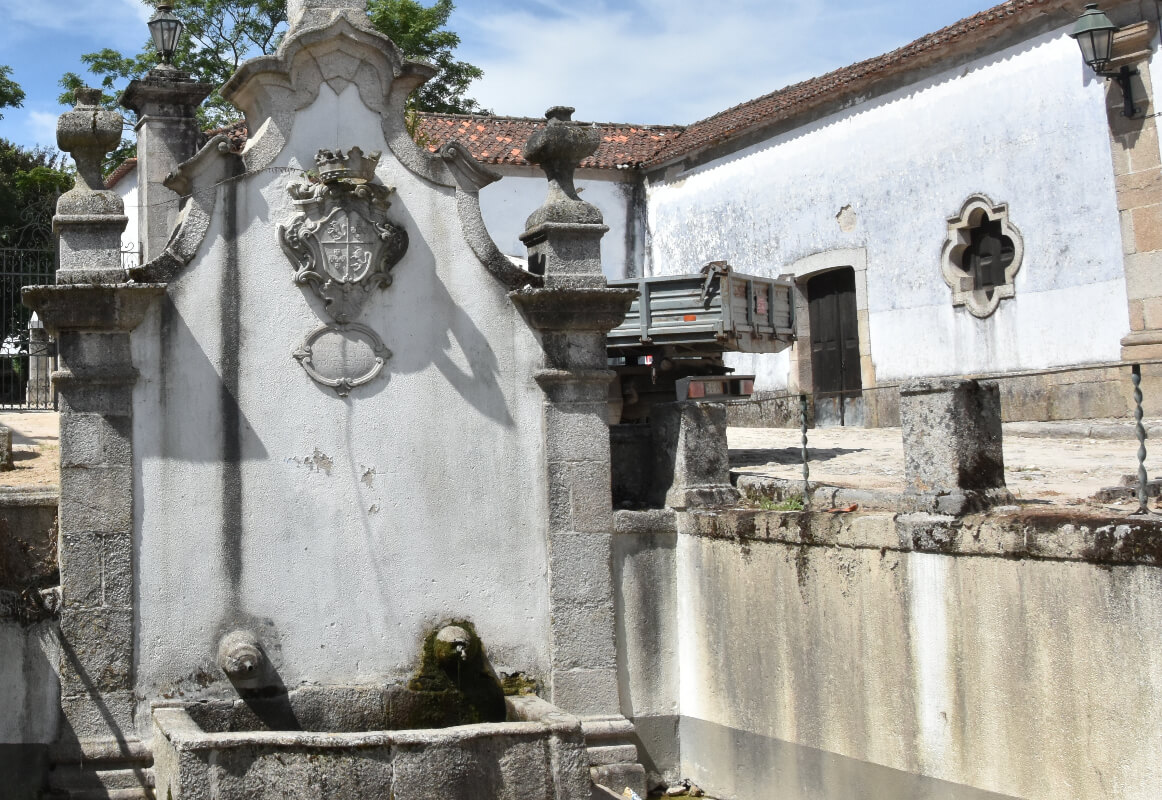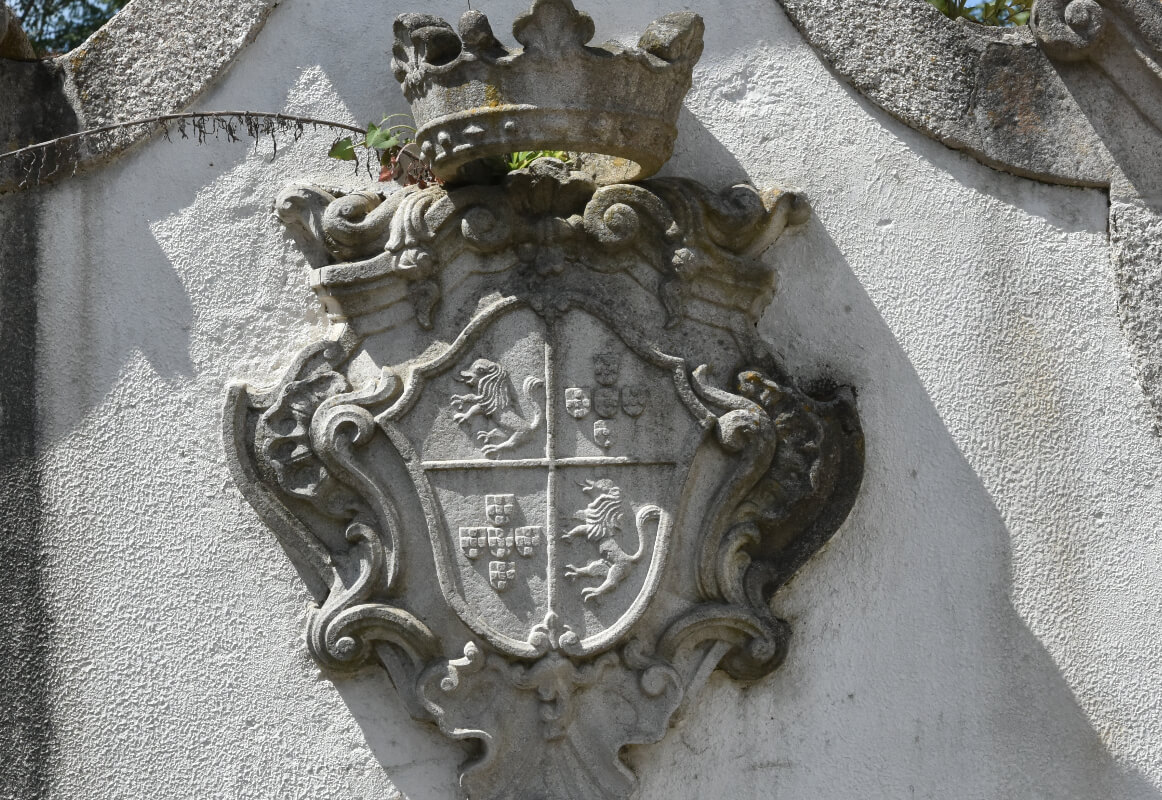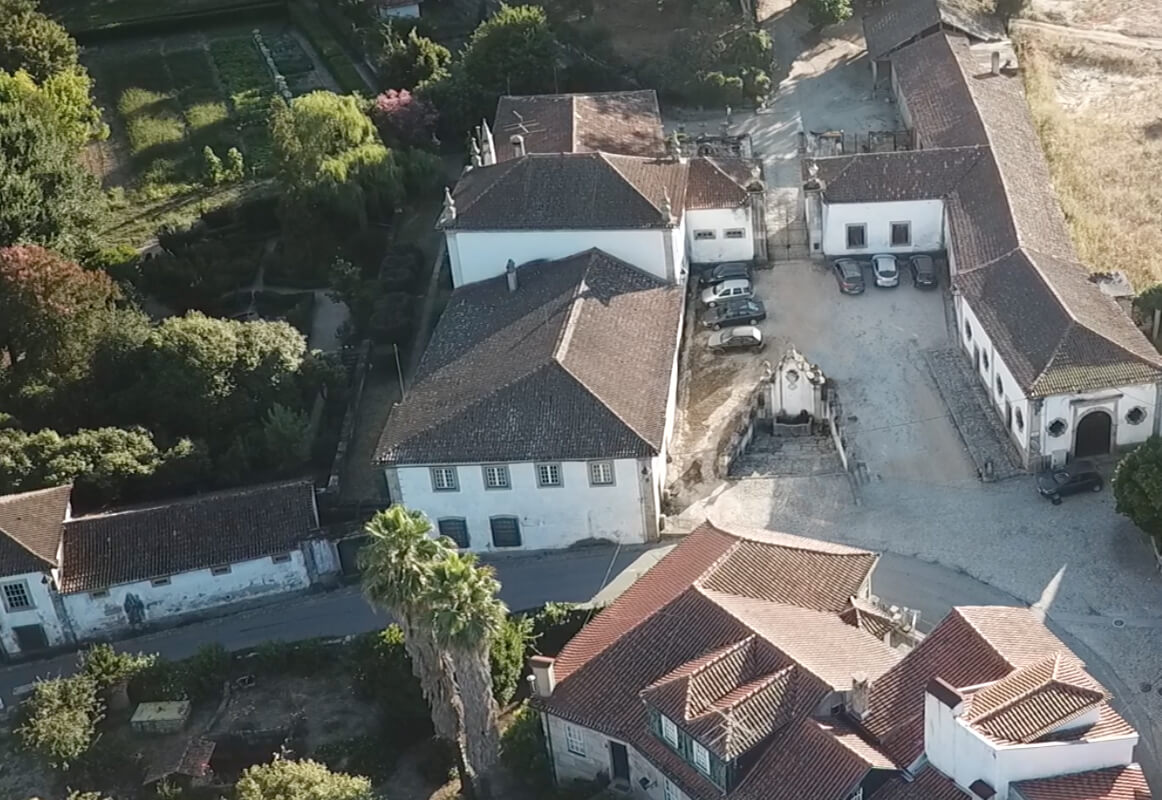Along with a vast set of religious buildings, Santar still preserves very interesting nucleus of various types of houses. The traditional rural house, the literate and wealthy bourgeoise house and the manor house, whose existence at times is blended with the History of Portugal itself.
Some of these houses, such as the most ancient ones are in ruins or advanced state of decay, but others preserve the greatness acquired throughout the centuries. Despite the different architectural styles, that refer to the times they were built, there is, a common element: granite. It can either cover a building’s facade or be used on walls, balconies or simply the framings of doors and windows. From the most modest to the most imposing, many of the houses in the village of Santar have this in common, they use this typical stone from this region.
Casa dos Condes de Santar e Magalhães
The manor house built with an agricultural and winery property, Casa de Santar e Magalhães is a good example of the mannerist civil architecture, combining both baroque and neoclassical characteristics. Located in the heart of the village of Santar it became the most relevant manor house and the one which would lead the main road artery in the village, after the destruction of the Paços dos Cunha.
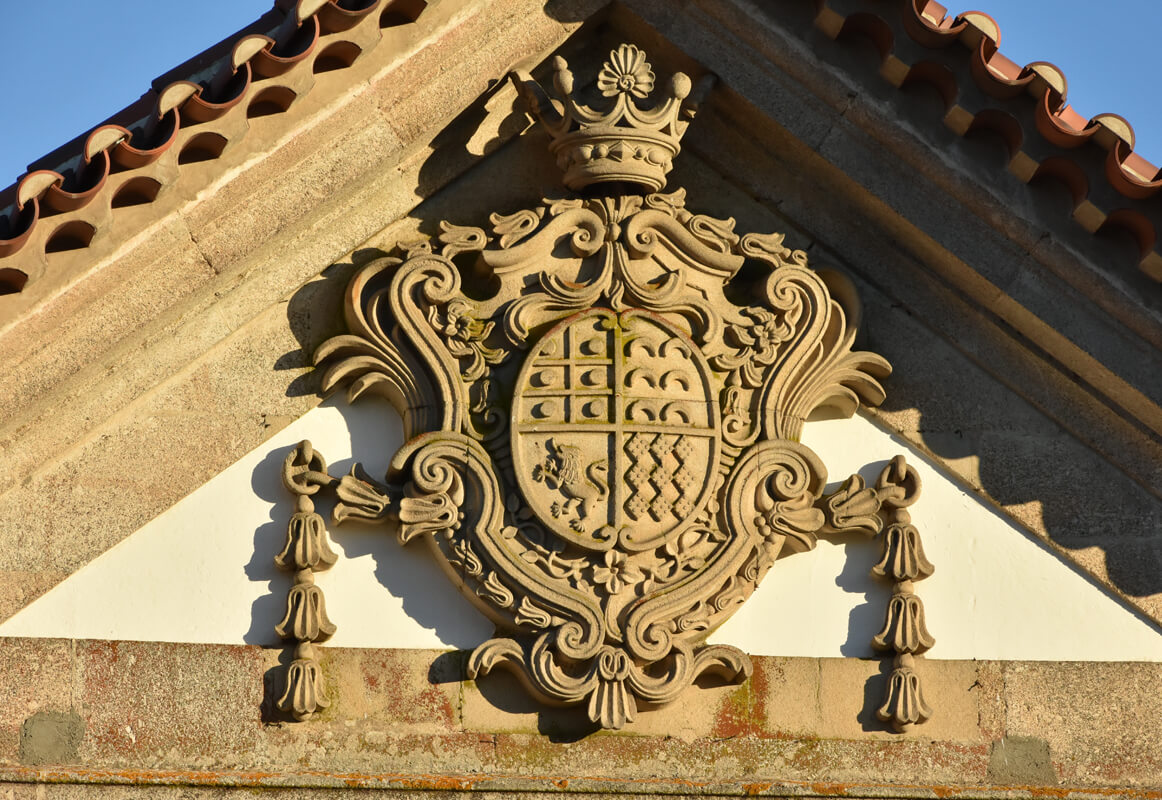
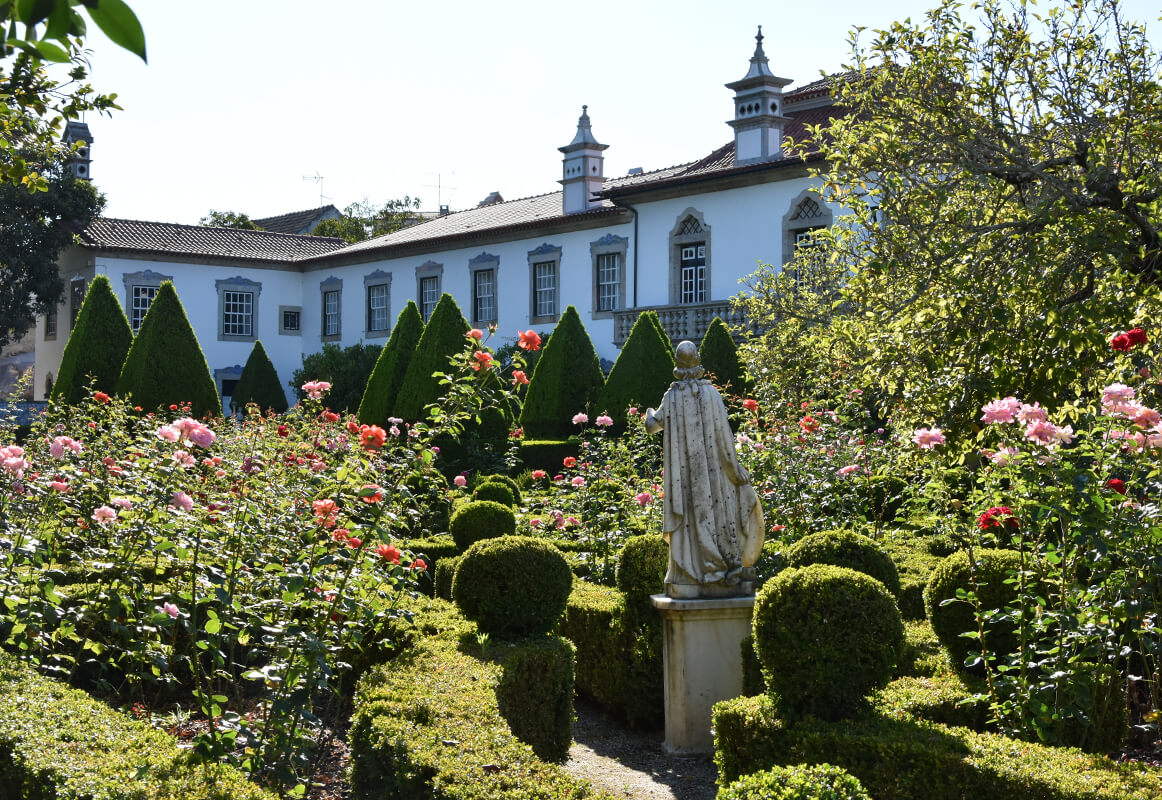
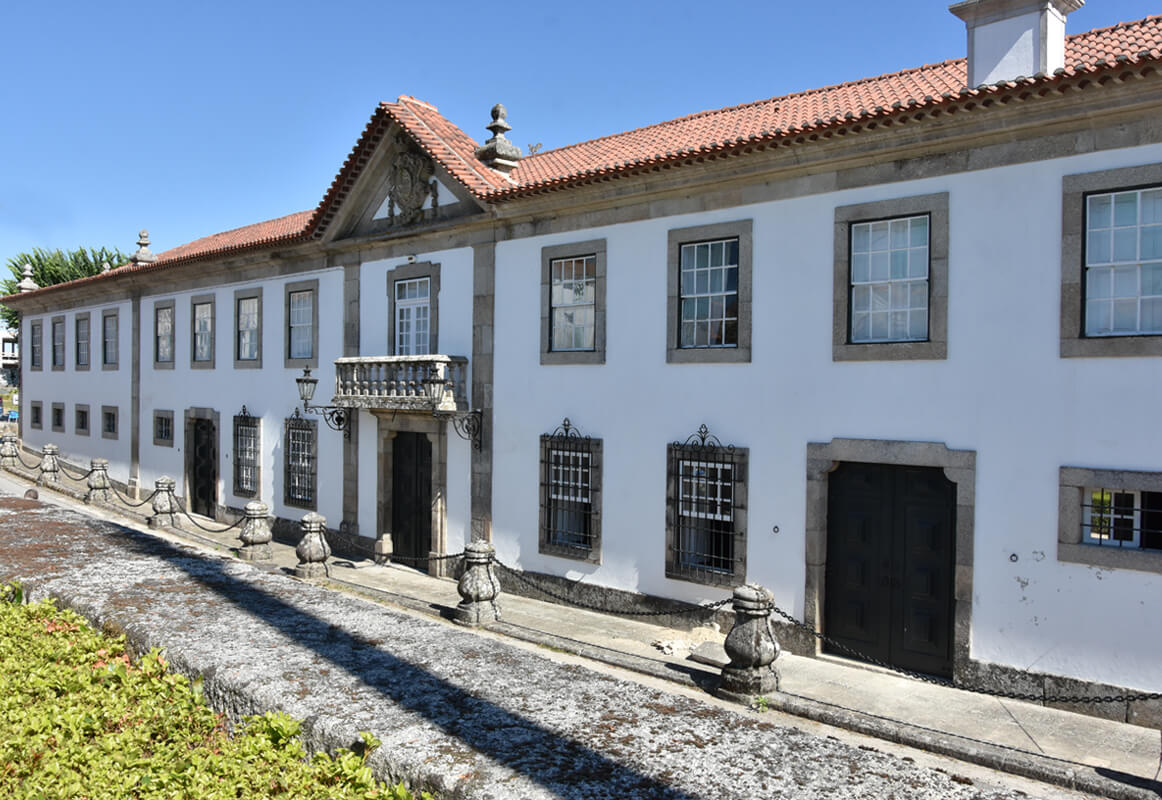
Although it has suffered innumerable additions throughout the centuries, it is not easy to distinguish the various construction phases because there has always been a concern to harmonize the new additions with those previously built.
The oldest nucleus was built at the turn of the 16th to the 17th century, by João Gonçalves do Amaral. Later, after the establishment of the “Bond of Santar” in 1670, his son Francisco Pais do Amaral and his wife Francisca Pais do Amaral ordered the construction of a chapel dedicated to St. Francis. The temple would only be finished by their son, António Pais do Amaral, in 1678, who was buried here. In 1690, also during the life of António Pais do Amaral the house underwent an extension with the construction of the so-called Old Kitchen.
With a rectangular floor plan, this magnificent room has the beauty of preserving in its interior a granite, porch shaped fountain with a spherical dome coverage, ornamented in the angles by pinnacles and whose entablature is supported by four Tuscan columns. At the same time, outside the kitchen, another fountain was built and decorated with figurative tiles signed by Gabriel Del Barco dated from the 1700s.
Inside the kitchen there is also a granite chimney, of great proportions and a pyramidal cover. The pillars that support it, as well as the respective cornice are ornamented with vegetal motifs.
Later, in the 18th century, a new longitudinal body was added to the house. Around 1727, Francisco Lucas de Melo, son of the first Francisco Lucas de Melo, began the construction of the wineries, the central courtyard and the imposing fountain known as the Fonte dos Cavalos, completed in 1790. In the centre, the coat of arms of the house is displayed under the water that flows from a grotesque mask to a granite drinking fountain. Later the fountain would become decorated with panels of tiles signed by Pereira Cão.
In the 19th century, on the side facing the garden, a running balcony is built supported by Tuscan columns and decorated with welcoming figures in tile representing the Four Seasons. From the beginning of the 20th century, a new addition is made to the house: a closed gallery also facing the garden and the tiles signed by Pereira Cão that cover the walls of the hall.
As for the main facade, the one facing the street, it reveals great sobriety. The parietal linearity is only broken by the existence of two levels of simple granite frame windows and built-in pilasters, which correspond to the level of the roof’s bulbous pinnacles. At the centre of the facade, the portal has a balcony door with a balustrade gallery. These elements are crowned by a triangular pediment where the family's coat of arms is inscribed. The separation between the house and the street is made by a set of bulky granite pieces connected to each other by a thick iron chain.
Casa de Santar e Magalhães has been in the same family since the 16th century. With the marriage of Maria Teresa Lancastre de Mello to José Luís d’Andrade de Vasconcellos e Souza in the 20th century, the representativeness of the illustrious houses is added with the family honour of Casa Real, Óbidos, Sabugal, Palma, Alva, and Santa Irira.
José Luís and Pedro Vasconcellos e Souza, heirs of this vast cultural and historical heritage, are the founders of the Santar Vila Jardim Project, along with the Ibérico Nogueira and Portugal Loureiro families.
Casa das Fidalgas
Although much was altered by the successive reforms - especially in the 17th and 18th centuries - Casa das Fidalgas dates back to medieval origin and started by being a medieval tower. The foundation of the present manor house, with a baroque and neoclassical architecture, was due to Domingos de Sampaio do Amaral, who raised it as the residence of his daughter, D. Joana de Sampaio, who would later marry João de Almeida Castelo Branco. They would be the holders of the captaincy of the municipality of Senhorim and the ones who established the morgado of Santar.
There is not much information on the work carried out over time. However, and by all accounts, it would have been in the middle of the 1700s that the larger ones would have taken place giving the house its present appearance. In fact, according to some authors, it would have been only then that the medieval tower was demolished. The memory of this structure would, however, remain in the toponym “Fonte da Torre”, a fountain ordered to be erected in 1789 by Rui Lopes de Sousa Alvim Lemos, in the front yard of his house.
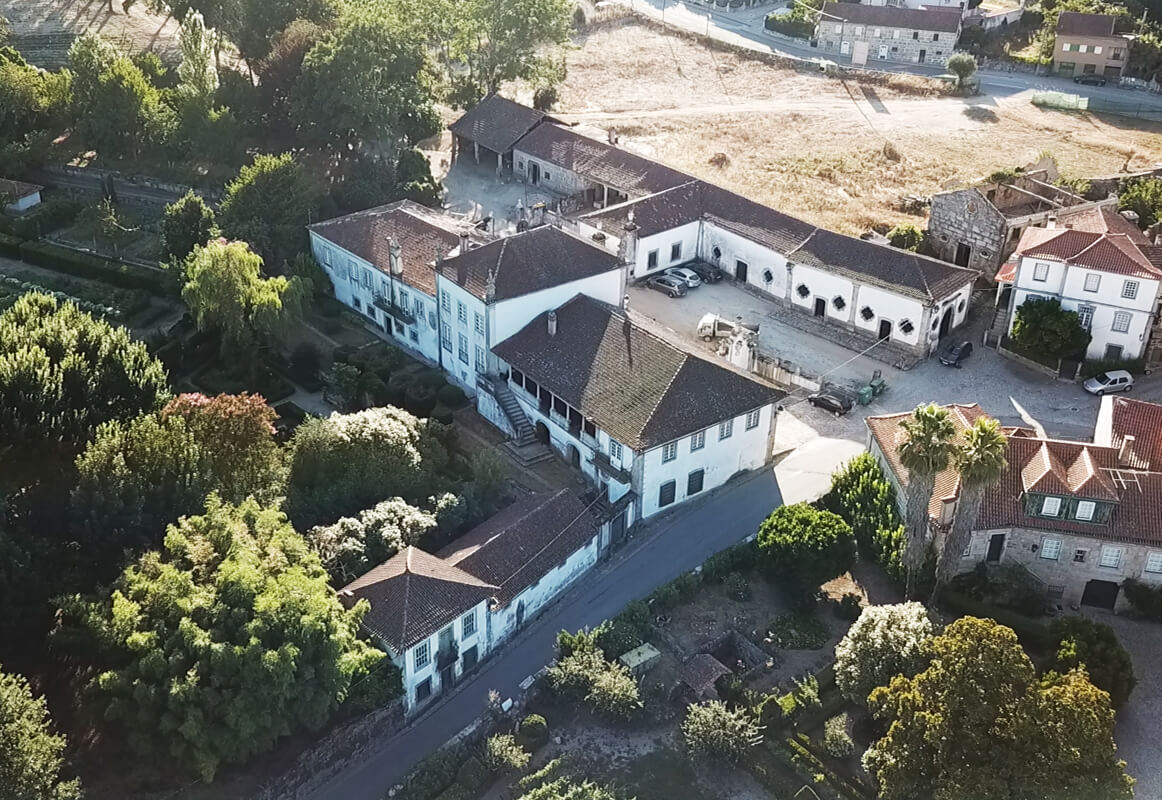
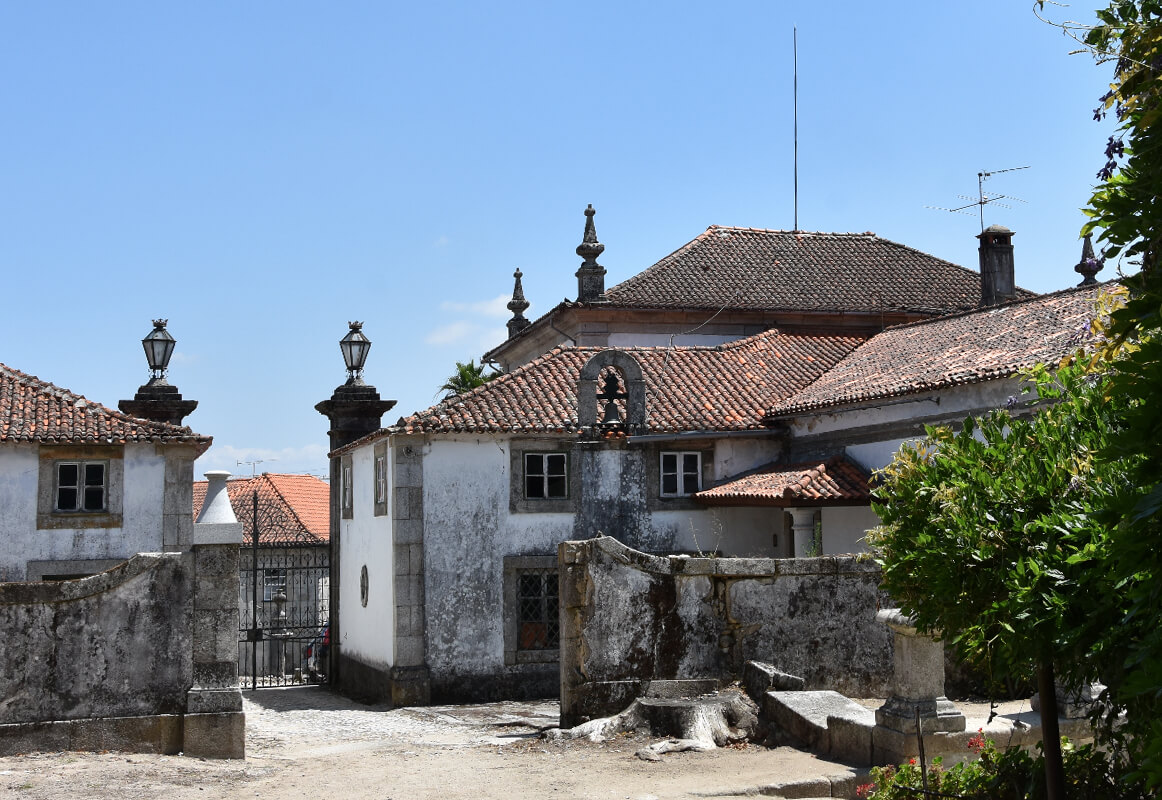
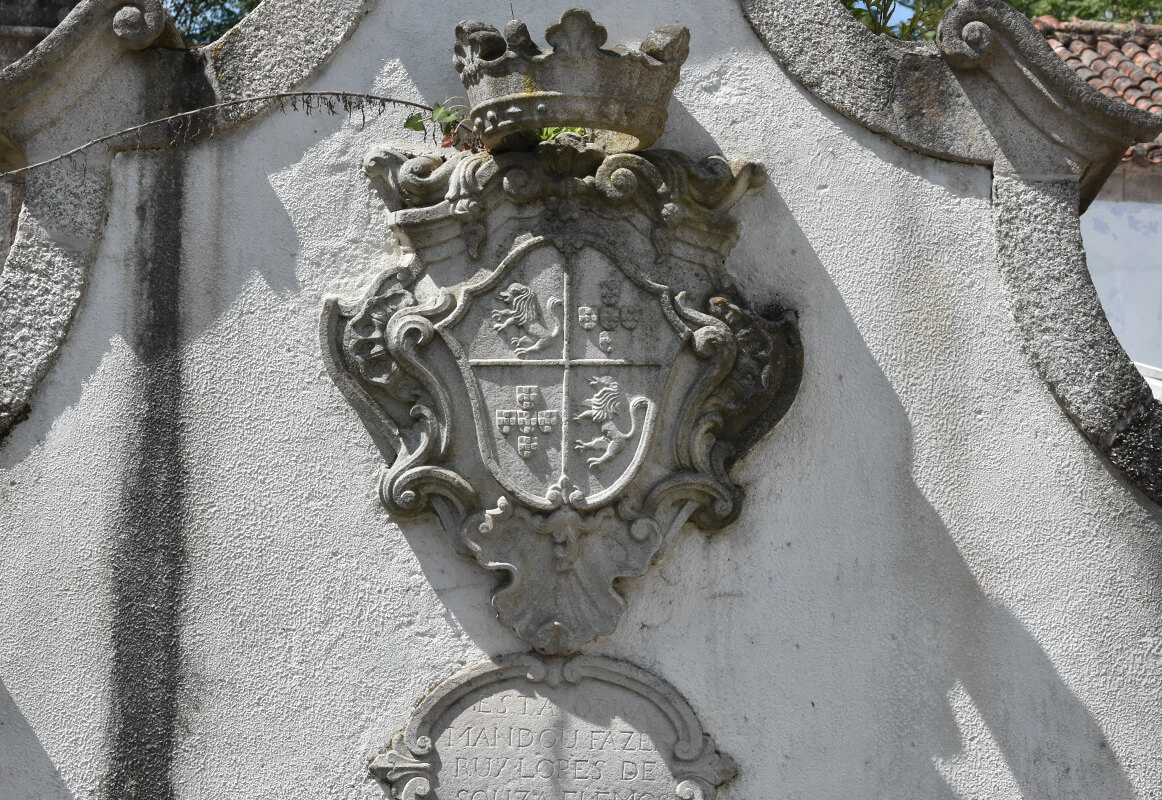
This manor house is made up of four bodies. The main facade is oriented to the northwest, divided into three two-story panels where simple frames and a porch supported by a column appear. In the back facade, facing the gardens, there is a porch facing the Tuscan columns that connects to the garden by a staircase.
In the interior, the ceilings are in wood or stucco. Among these, there is one that stands out, with a very unusual decoration of inlaid plates forming a circle, in the centre of an even bigger plate.
In Casa das Fidalgas there is still an oratory worthy of mentioning. Built in the middle of the 18th century, in the transition from baroque to rococo, it has a green and gold decoration, rich in windings and decorative motifs that contrast with two red curtains that hang laterally. On the painted background imitating brocade, an 18th century figure of Christ. Next to it, a medieval polychrome sculpture dating from the late 14th century - perhaps from the medieval foundation of the house - representing the Virgin and the Child. Not part of the Oratory, but in its proximity, is a baroque image of St. Peter sitting on the throne with the papal attributes.
Until 1975, the house would remain in the family is origin. It would be its last heir, Pedro Brum da Silveira Pinto, who would donate it, along with the agricultural property, to the representative of the Portuguese royal house, D. Duarte Pio and his brother, D. Miguel de Bragança, Duke of Viseu, who still inhabits it until this very day.
Paço dos Cunhas
A manor House built in 1609 by Dom Pedro da Cunha, nobleman of the court of D. Filipe II, son of D. Luis da Cunha, Lord of Sabugosa, Óvoa and Barreiro.
In 1640 the Cunhas stood with Spain against D. João IV, and were therefore exiled and their property was confiscated. The long facade of its fence reveals a Mannerist architecture. To the centre, we find the coat of arms of the Cunhas, surmounted by a half circle, whose interior boasted the coat of arms of Dona Elvira Coutinho de Vilhena, wife of D. Pedro da Cunha.
Of this completely destroyed manor house, only the ruins of the barn, stables and cellars were left. They were restored by the Global Wines Company, and are currently an area of wine tourism, catering and events.
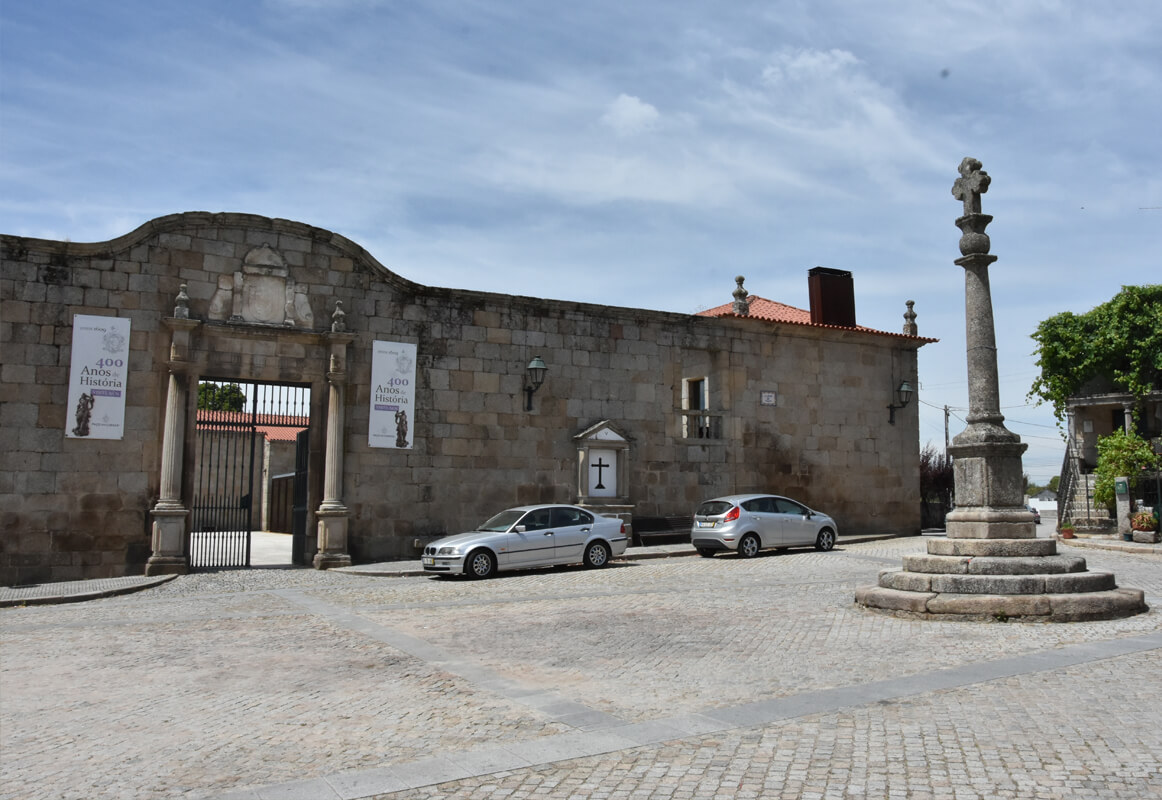
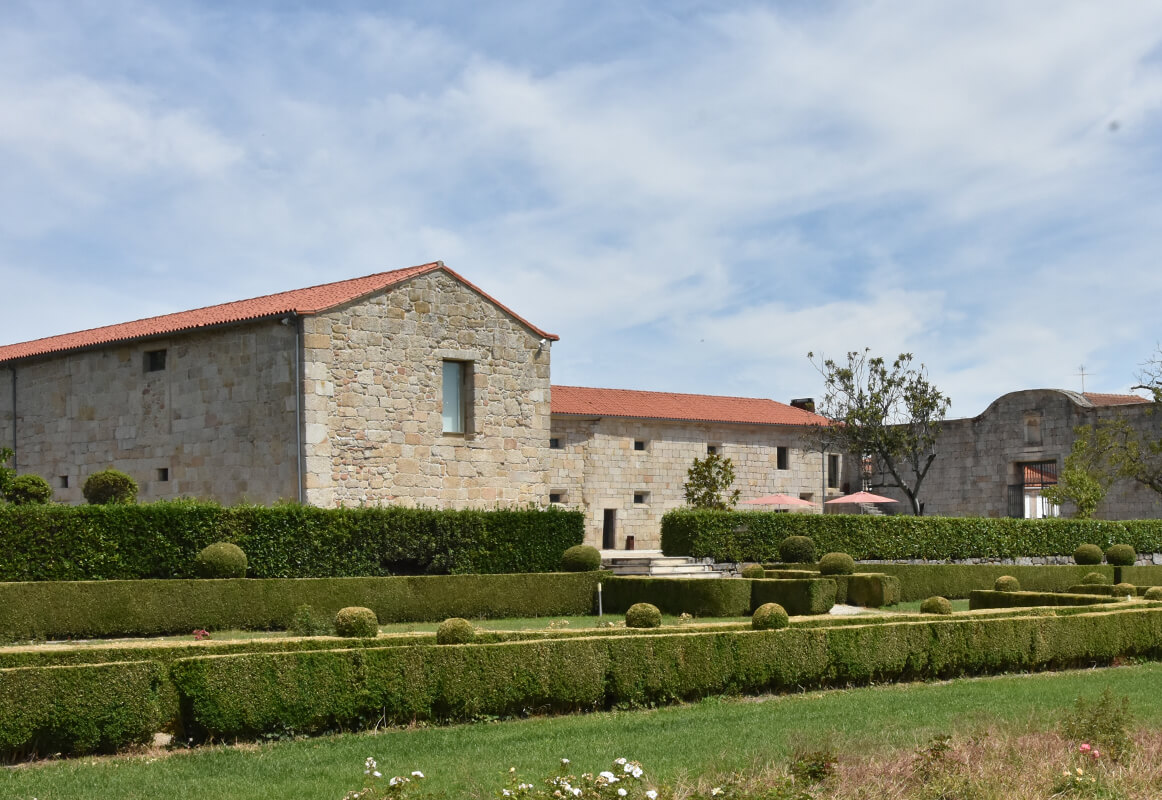
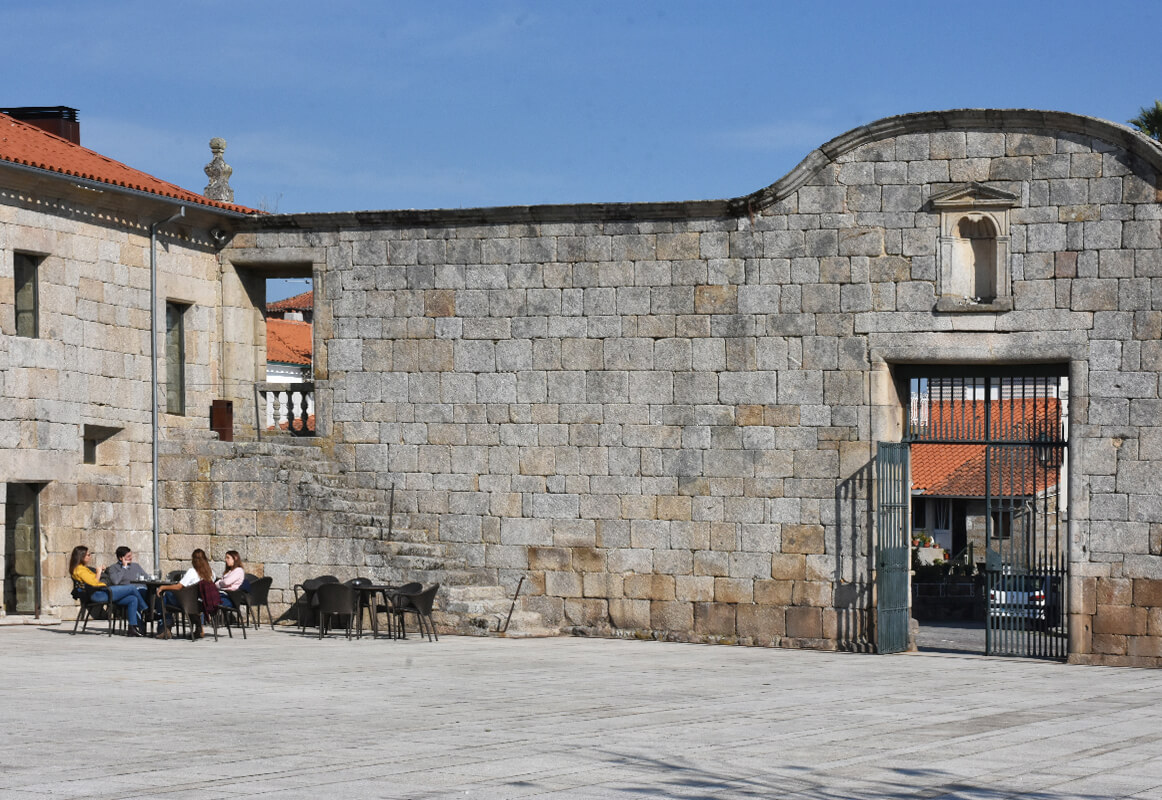
Casa do Soito
Having been originally built in the 17th century, the Casa do Soito has been linked to Paço dos Cunhas since the beginning of the 19th century, when the two properties belonged to the same family, José Caetano dos Reis.
Casa do Soito belonged to the other son of Caetano dos Reis, Manuel Casimiro Coelho do Amaral Reis, whose coat of arms is clearly visible on the main door.
It benefits from a whole apparatus of scenography that is conferred to it either by the access staircase or by the decoration of the facade, or by the gardens developed at different levels, with balustrades, tiled benches and statues.
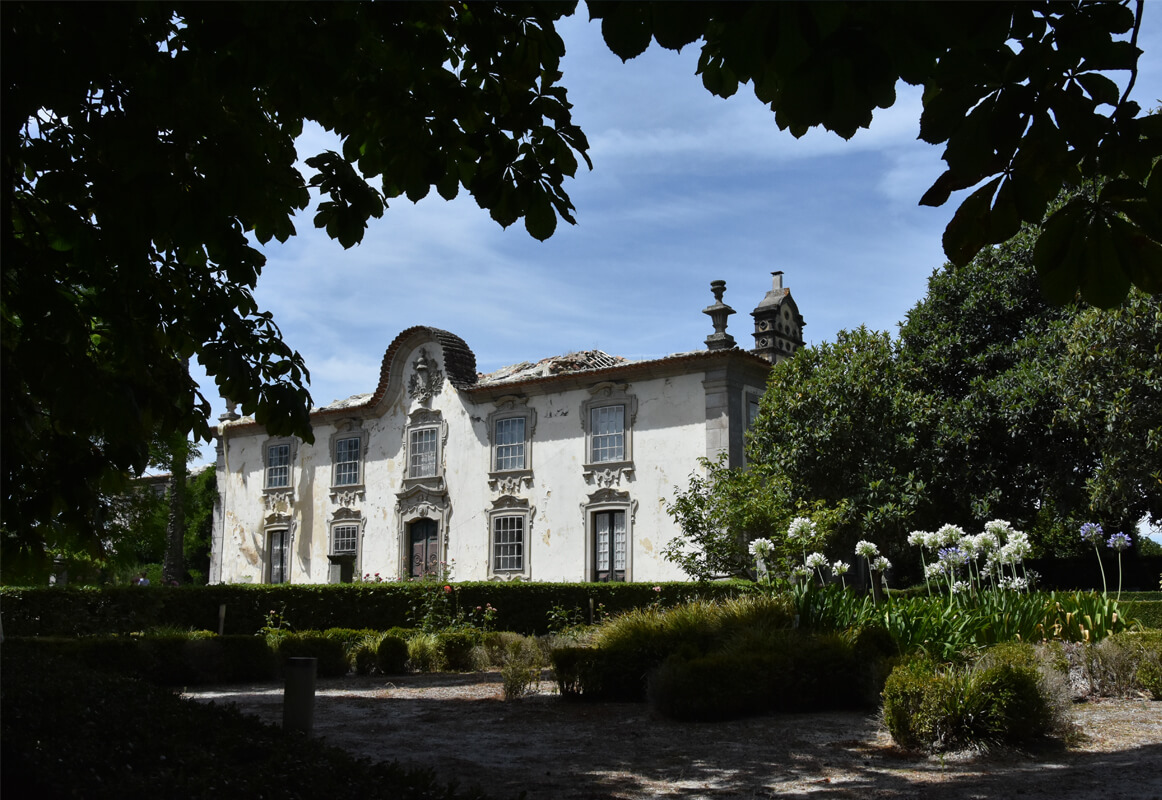
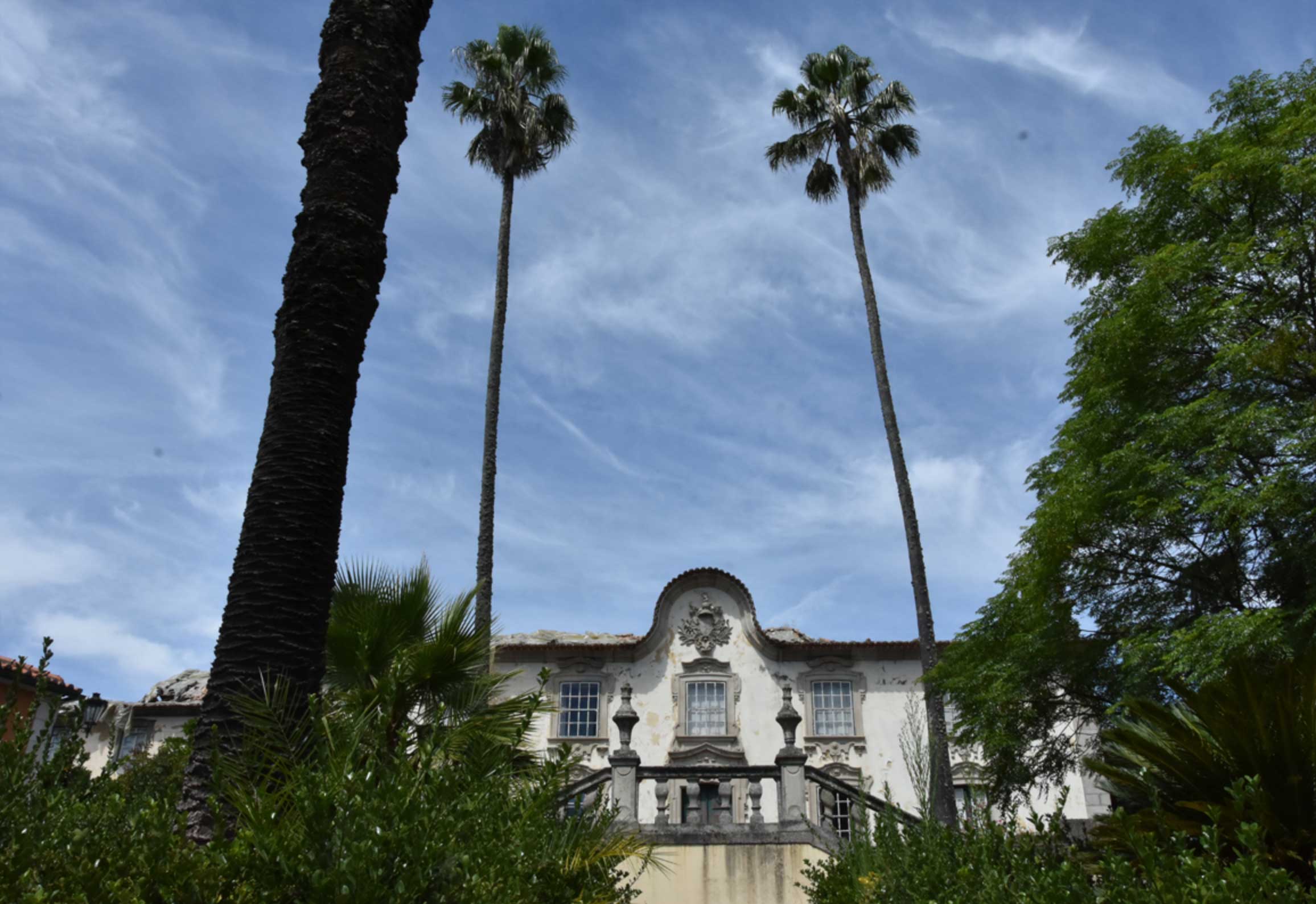
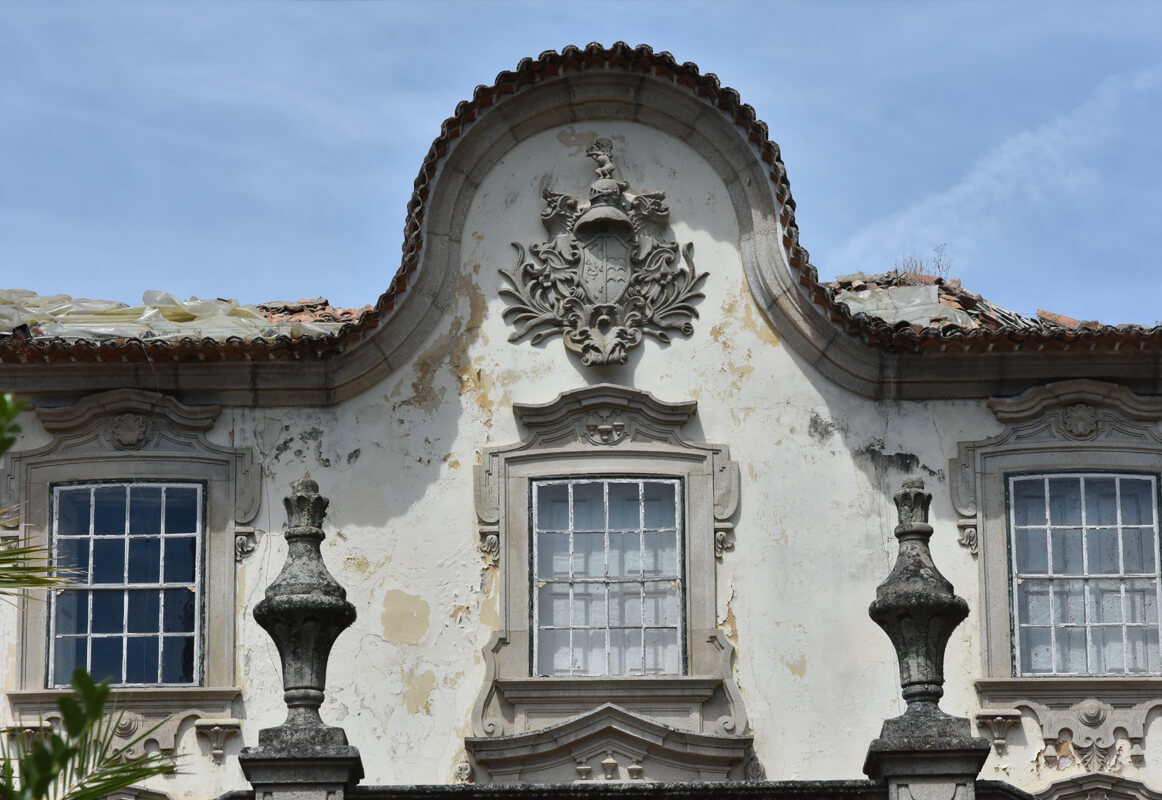
Casa Ibérico Nogueira
Located in the heart of the village of Santar, Casa dos Linhares or Casa Ibérico Nogueira is a good example of an urban house for the Beira Region with an agricultural past. Built in granite, it has two floors and an attic. Initially, the ground floor corresponded to agricultural dependencies. The first floor was the residence of the owners of the house.
Apparently, this construction is from the early 19th century. The house and the associated farm would be acquired by a public deed in 1900s by Manuel Joaquim dos Santos, the paternal great-grandfather of the current owners. It is likely that his intention was to leave a house for each daughter since he had another one in this village, in the Avenue Viscondessa de Taveiro (next to the current reception area of Santar Vila Jardim), where he lived until the end of his life.
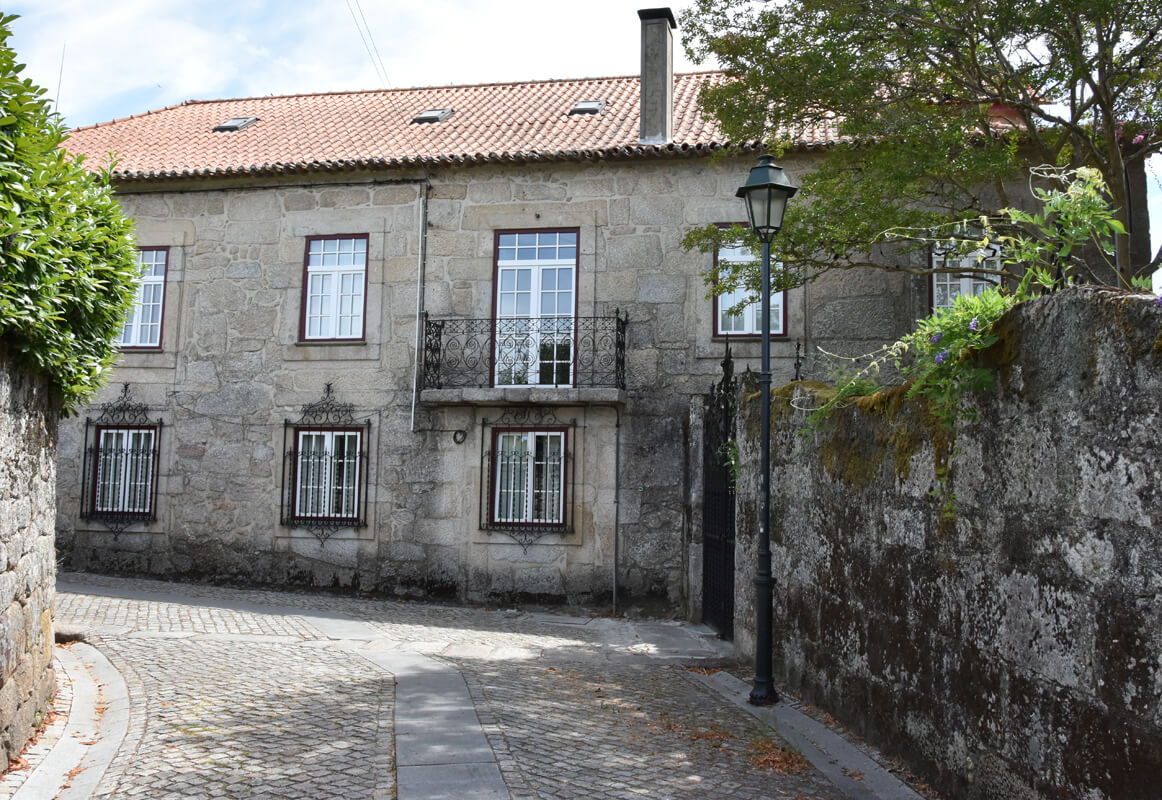
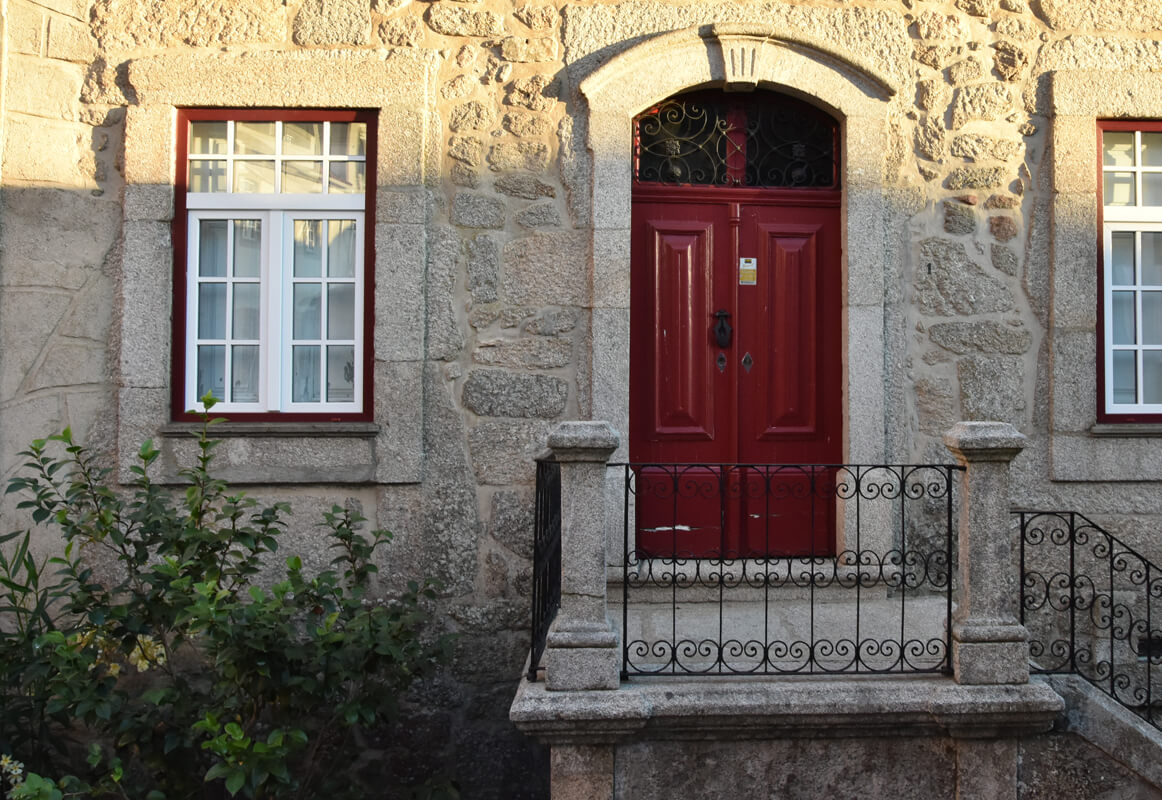
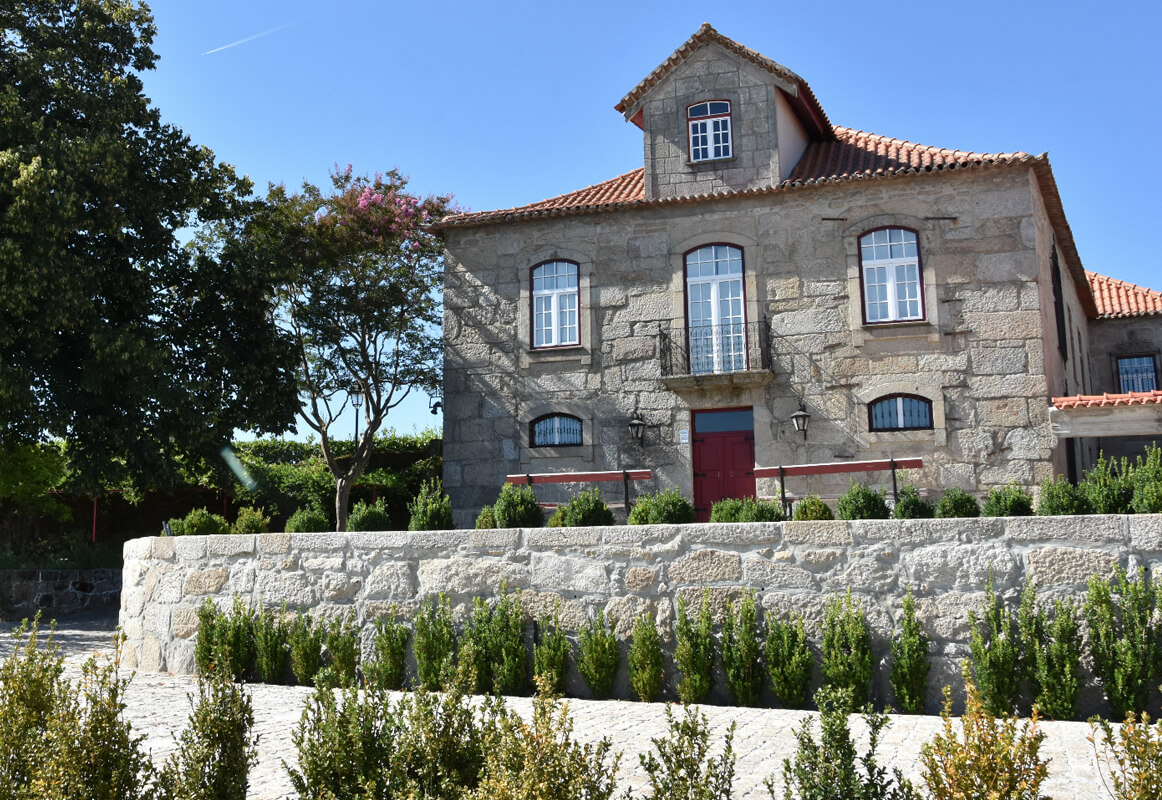
Manuel Joaquim dos Santos was a successful trader. He was married to Ana Neves dos Santos and had two daughters: Maria Celeste, the oldest, and Sara, the youngest. Both would come to receive a careful education and revealed great talent for drawing, painting, and music, having Maria Celeste become an excellent pianist. She would marry António Ibérico Nogueira in 1914 and receive a marriage gift, from her parents, the Casa dos Linhares, where the couple came to inhabit.
António Ibérico Nogueira was originally from Lisbon and had a military career - at that time lieutenant of cavalry. He entered the Military Academy under the influence of an uncle António Rodrigues Nogueira, also a military engineer. This man from the Beira had gained some influence in the capital and was one of the main founders of the Hydroelectric Company of Serra da Estrela and the Companhia Portuguesa dos Fornos Elétrico (electric ovens).
António Ibérico Nogueira and Maria Celeste had two children: Francisco, the eldest, born in 1915 and Maria Alice, who was born two years later.
Loyal to the monarchical cause, captain Ibérico Nogueira would participate in the numerous attempts carried out by Paiva Couceiro to restore the monarchy. In 1919, during his last attempt, Ibérico Nogueira, then commander of the Cavalry Regiment of Nelas, would join with "his" men to the so-called Northern Monarchy, established in the city of Porto in January 1919, which only lasted 25 days.
When the uprising was stopped, he was arrested and exiled, first in Madeira and then in Mozambique, and expelled from the army. During his exile, which lasted about six years, Maria Celeste stayed with her children in the Casa dos Linhares.
Following the revolution led by Gomes da Costa, which put an end to the 1st Republic, on May 28th, 1926 he would be amnestied and allowed to return to Portugal. He would not, however, be reinstated into the army. Nonetheless, the knowledge of topography that he had acquired there gave him a new profession: a topographer, making topographic surveys for the construction of high voltage lines. It is in this context that he begins to collaborate with the hydroelectric company of Alentejo, building a line between Nisa and Maceira, to feed a cement factory. In the 1940s he settled with his family in Maceira.
That is when the Casa dos Linhares stops having permanent residents and is mostly used on holidays: Christmas, Easter, and September. Maria Alice Ibérico Nogueira, daughter of António and Maria Celeste, goes to live in Viseu after marrying Antonio Lacerda Pinheiro, a doctor at the Sanatorium of Caramulo.
In 1939, his son Francisco would complete his education with distinction, in Medicine. Invited to become an assistant at the same College, in Coimbra, in 1960, he became a full time Professor. He distinguished himself as a doctor and researcher, having introduced innovative techniques in Portugal, in the fields of Obstetrics and Gynaecology, his specialty. He married Maria Emília Osório do Amaral and Sousa Pinto da Cunha Mora, the great-granddaughter of the Viscount of Almeidinha, owner of Casa Almeidinha, located at a short distance from Mangualde and, therefore, not far from Santar.
From this marriage seven children were born four boys and three girls: António, Isabel, Francisco, Margarida, José, Maria do Rosário and João. When Maria Celeste died, in 1972, the Casa dos Linhares would be inherited by the two children. Subsequently, Maria Alice, who had no offspring, would donate her share to her brother.
With a large family and a passion for Santar, Francisco Ibérico Nogueira introduced several improvements to the house. In the 1960s he built the existing walls surrounding the property, demolished the corrals and stables - building a large stone courtyard and a shed in its place - opening irrigation wells and introducing various improvements in the interior of the house. During the 1980s, after having lived five years in Brazil, he renovates its interior giving it new dependencies.
After the death of Francisco Ibérico Nogueira, in 2009, the property of the Casa dos Linhares is inherited by his son João, who shares the right of use with several of his brothers, as a way for all siblings to stay connected to Santar. Also, in that year, João Ibérico Nogueira, his wife and their children constitute the company Iberparticipa, S.A., which includes the project Santar Vila Jardim.
Casa da Magnólia
Property of the family Pinto Amaral Homem, the Casa da Magnólia, is named after its penultimate owner, Maria Adelaide Portugal, who thus intended to pay homage to a 200-year-old magnolia grandiflora that existed in her garden.
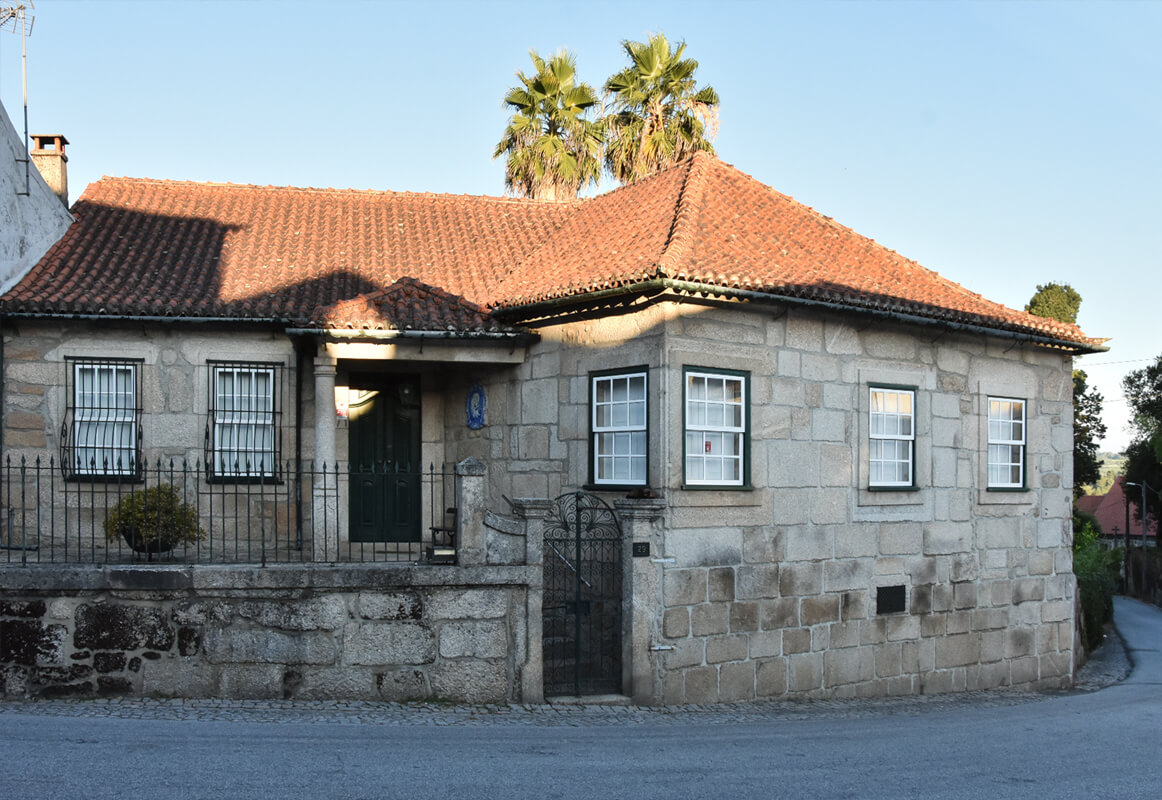
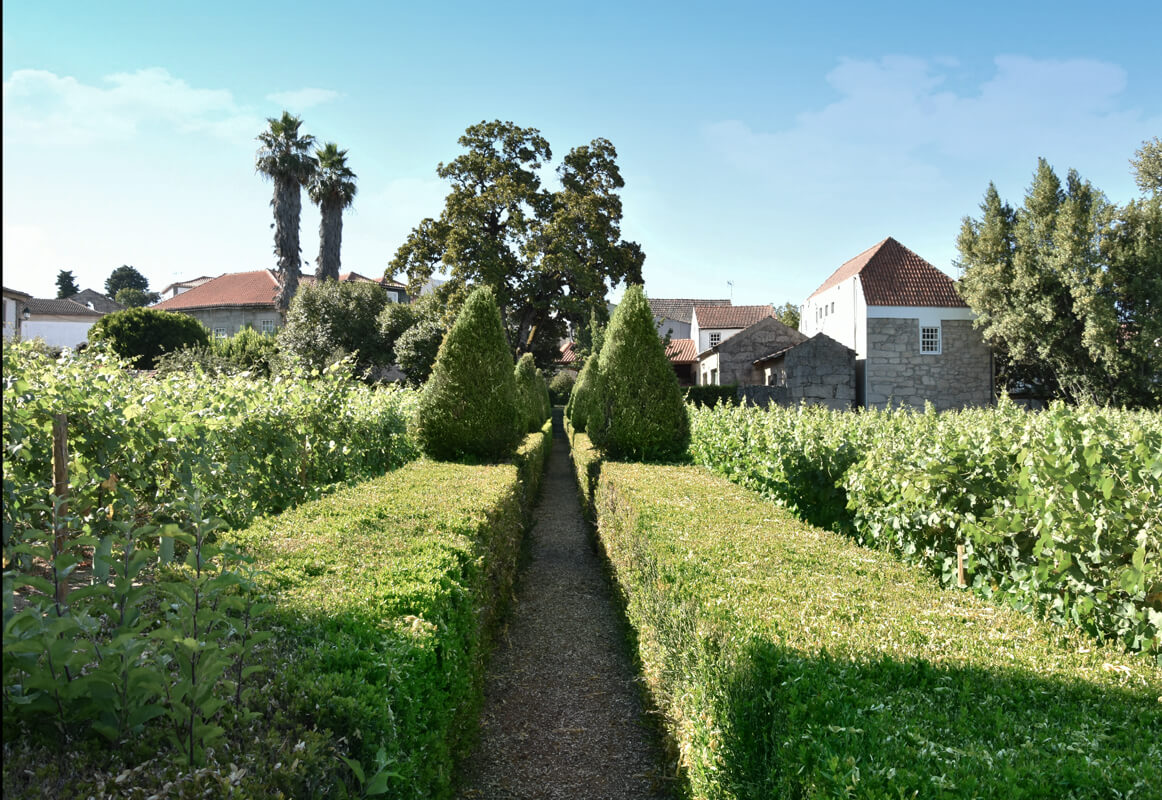
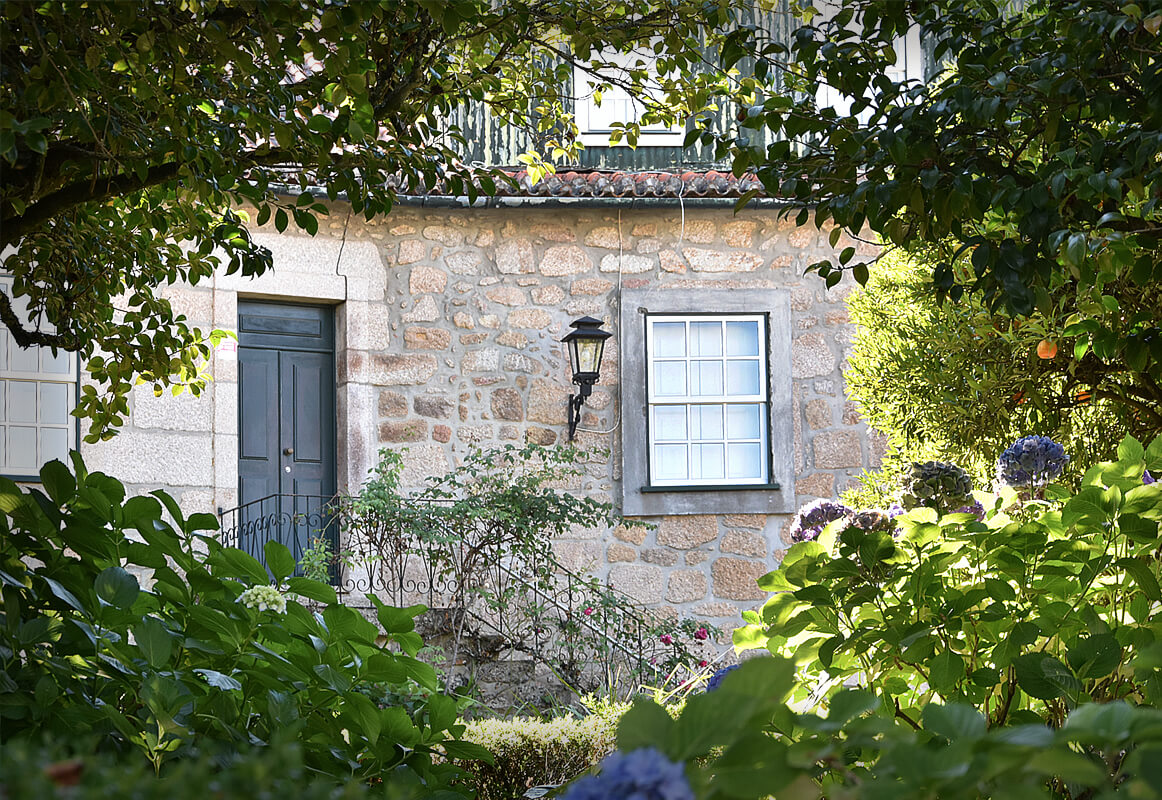
The origin of this house dates back to the 17th century, when Francisco Pinto came from Azinhaga to Santar, with his sons, the abbot Sebastião Pinto and Pedro Coelho Rosado.
In 1727, one of the descendants of Pedro Rosado de Coelho, Francisco Pinto Coelho Homem Rosado de Sampaio, Major-Captain of the municipality of Senhorim, married Maria Teresa de Portugal Mendonça Cabral. The surname Portugal would be restored in 1881 by the third-last owner of this house, the Veterinary Captain José Maria de Miranda Pinto Portugal.
Like others in Santar, this family could be characterized by belonging to a literate and urban bourgeoisie - exercising differentiated professions - but with strong rural ties.
The property to which the Casa da Magnólia belongs to is reflected in the design and distribution of spaces, a triple functionality: agricultural (the most important) residential, and recreational.
The agricultural area included farmland, orchards, and agricultural dependencies: wineries, barns, fermentation tanks, barrels, tunnels, corrals, and chicken coops. Today, it has a vineyard bordered by boxwood that occupies great part of the old agricultural area.
Two dozen of peripheral lands scattered throughout the villages of Santar, Moreira and Casal Sancho, make up the property with sowing land, olive groves, vineyards, gorses, and pine forests.
The two-story house is near the Casa de Santar e Magalhães. As usual, in this type of buildings, the first floor is reserved for the residential area and the ground floor consists of shops used in agricultural activities.
In the gardens of the house, and beyond the imposing Magnolia, which is covered by its beautiful white flowers in summer, innumerable camellia trees give it a special beauty.
In the warmer months, the shade of these trees brings a touch of freshness that is amplified by the water elements, namely the granite tank and the well with its old water wheel indispensable elements in a farmhouse.
Solar Nossa Senhora da Piedade
The manor house and the chapel of Nossa Senhora da Piedade are an example of a type of construction that grew horizontally from a tower house that was increased over the centuries, according to the economic power of its owners.
Since the 16th century, it grew in a random way, occupying free areas of land. However, in 1728, the Reverend Father Manoel de Abreu Castelo Branco built the chapel with his name on it which appears in the legend on the chapel's door. In the interior of the small temple, we highlight the main altar in gilded carved wood and the ceiling of the chapel with coffins painted according to local taste. They represent scenes from the life of Christ, from birth to the resurrection, including the representation of the Evangelists and Apostles, highlighted by the golden beauty of the frames in carving totally reflecting the Portuguese baroque style, where the concept of horror to emptiness is very well expressed. The figure of the patron saint is very well centred in the polychrome painting. The lateral quarrels that allowed the masters and servants to attend Mass without mingling with the rest of the people are also a point of interest.
In the exterior, the granite counter stands out, with a supporting spiral column and a roof with wooden coating, as well as the simple facade of the chapel, enriched only by the door and the oculus with vaults.
After years of abandonment, this manor house was acquired and restored, bringing back the brightness of past times. The visitor can feel, in this house of prayer, the true devotional spirit, where the artistic proliferation is to praise God.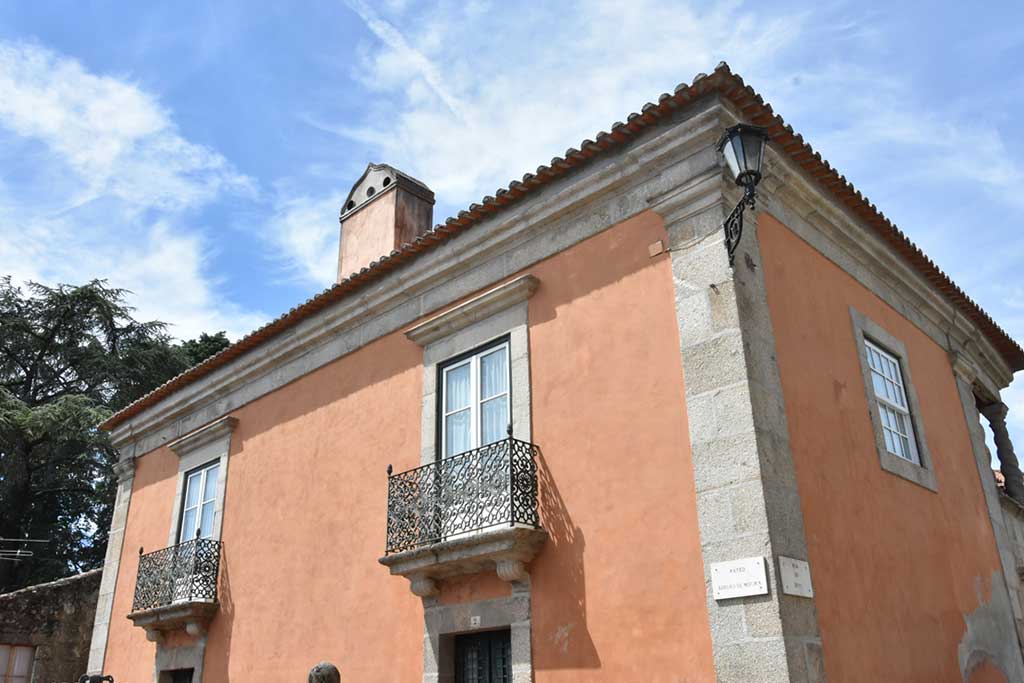
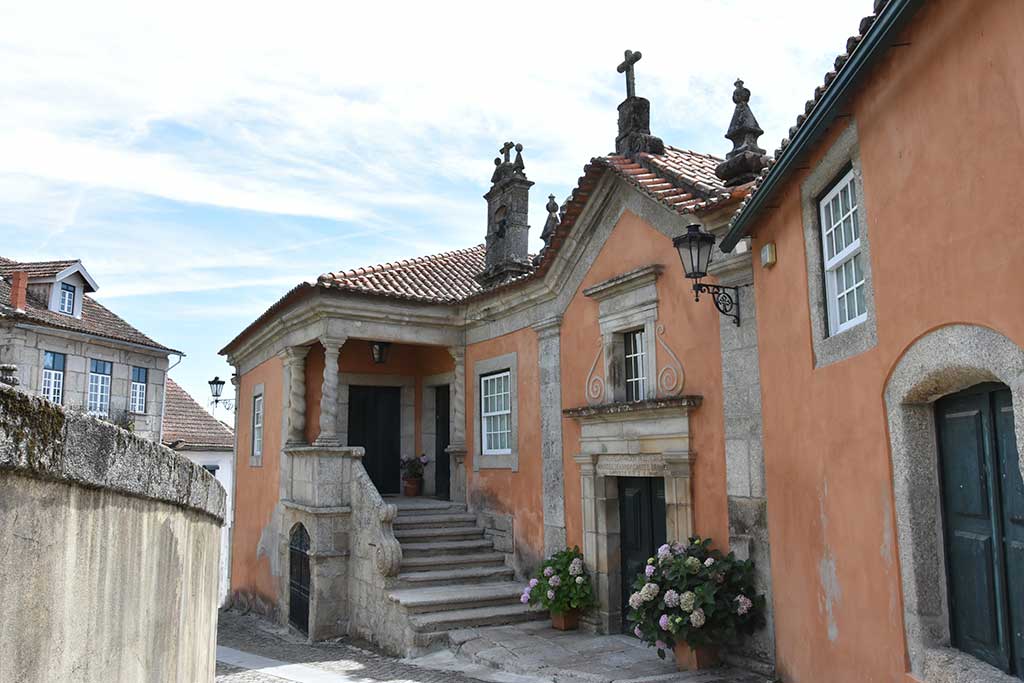
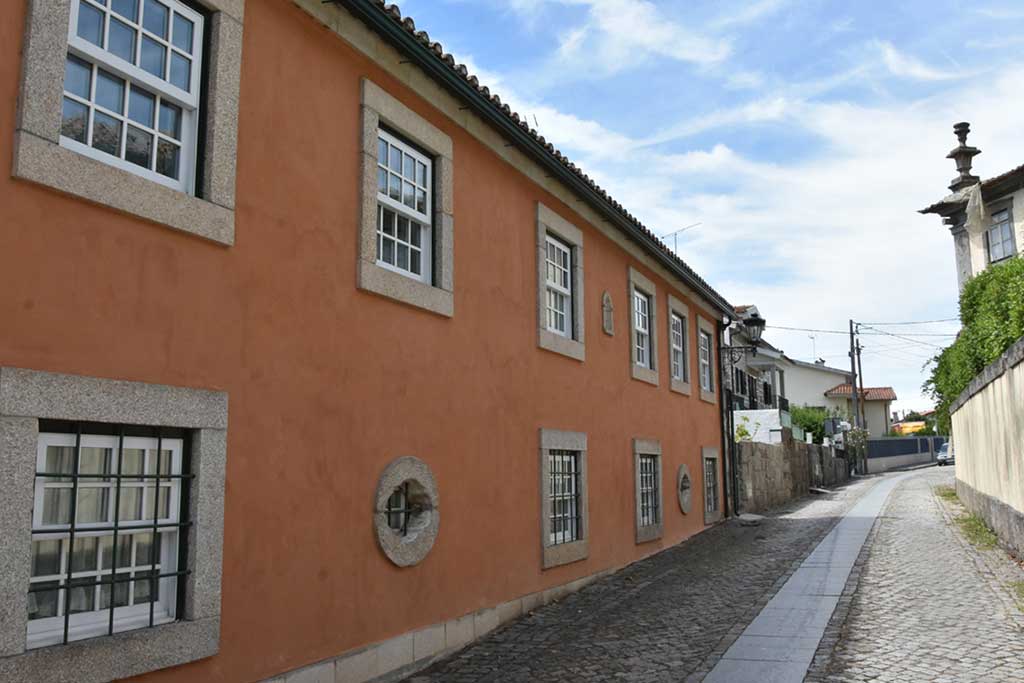
Casa do Passal
The regular visit to the Gardens of Santar, after walking through Casa das Fidalgas Garden, takes the visitor to Largo de São Pedro, near the Cruzeiro, next to the Parish Church, whose patron is São Pedro (Saint Peter).
In this square, you will also find Casa do Passal. Today a private residence, but which was previously owned by the Catholic Church and served as a residence for the parish priests who passed through Santar.
The word "passal" comes from "step", in this case a unit of measure that defined an agriculture area intended for the sustenance and the place of the priest in office. These areas were an enormous privilege for the Catholic Church, having been in force since the 9th century until 1869, when it was withdrawn, despite its vehement protests. However, in the case of Santar, it was only a few years later that Casa do Passal (residence and attached land) was transferred to the private domain, after a period of transition in the possession of the State.
Currently, this house is owned by Pedro Sampaio and his wife, Dona Isabel de Ibérico Nogueira. The couple bought the property, which was almost in ruins, rebuilt it, maintaining its original rural character, and preserving its exterior in stone masonry without any alterations. The rustic style of the interior has been modernized, using wood, both in the structure and in the coatings.
During the rehabilitation of Casa do Passal, numerous worked stones were found, integrated into the walls or sometimes already loose, sometimes in the form of colonnades, and other times engraved with inscriptions and drawings of games, revealing traces of the important Roman place that, at the time, was established in Santar.
Of these remains, the most important one found is a representative sculpture of Janus, a prominent figure in ancient Roman mythology.
The owners wanted to provide a view of this curious archaeological find to anyone who visits Santar, so it can be seen from the outside of the house through the window located on the right side of the main entrance door of the house.
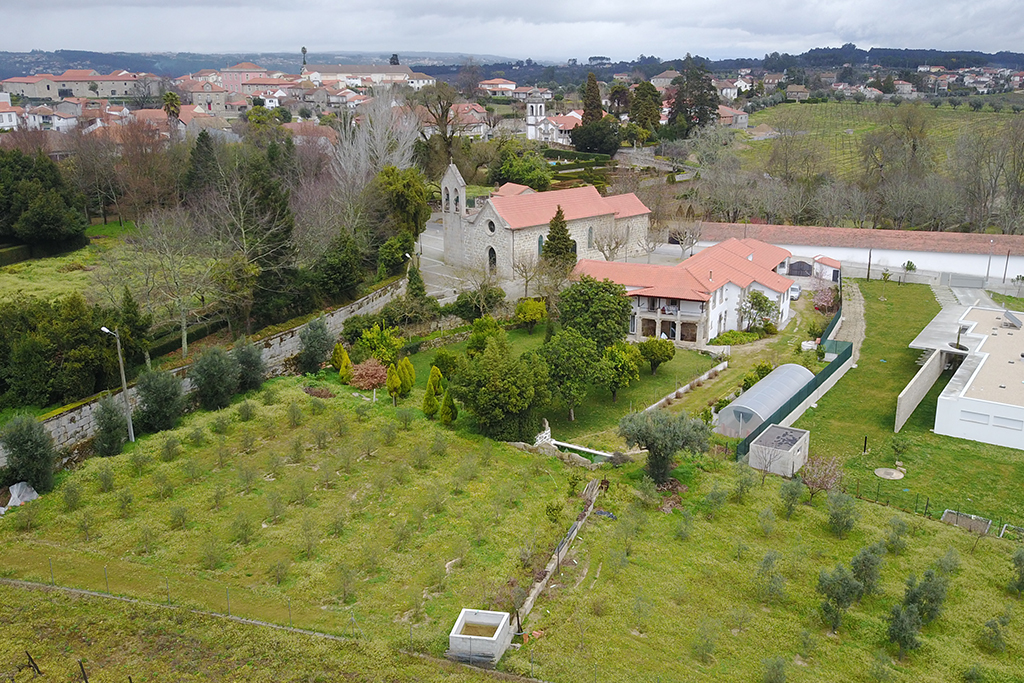
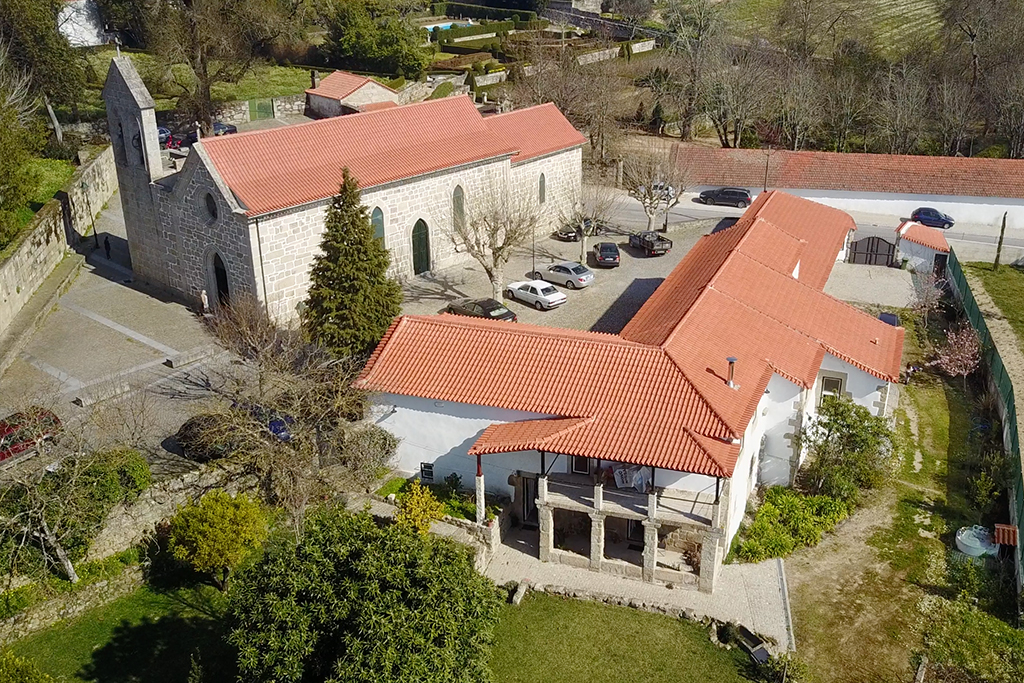
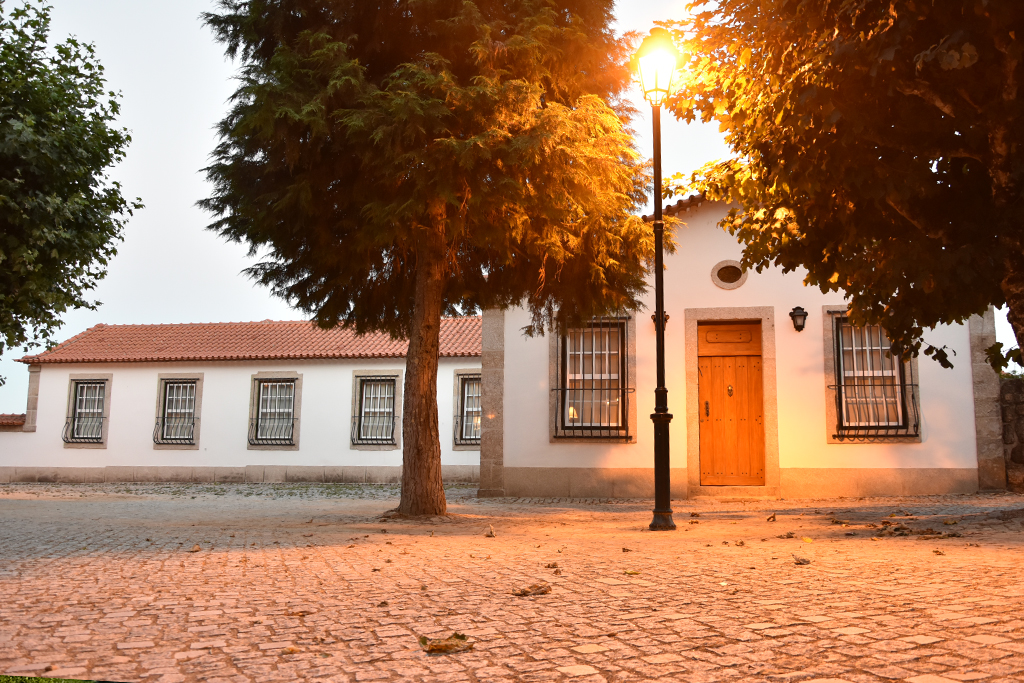
Casa do Miradouro
Casa do Miradouro was built by Duarte de Mello de Souza Telles de Menezes Pais do Amaral in the second half of the 19th century, with the first insurance policy dated 1860.
His personal taste for the architecture and avant-garde buildings of that time led him to accomplish this project in 4 years. For the execution of the building, he sells the property that he owns in the lands of Penalva do Castelo and which he inherited from his mother's house, now Casa de Santar e Magalhães.
This nobleman was the son of José de Mello Pais do Amaral and D. Maria das Dores Souza and Menezes, grandparents of the first Count of Santar, family with whom he keeps a close and affectionate relationship.
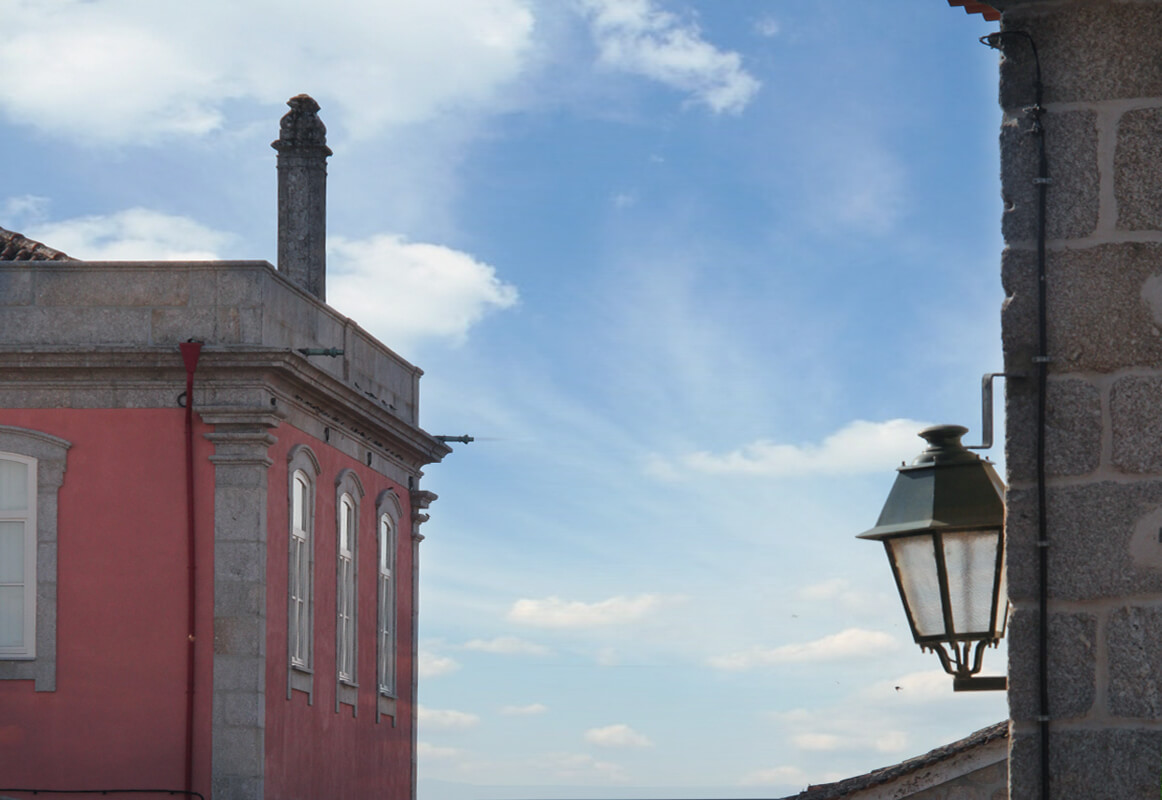
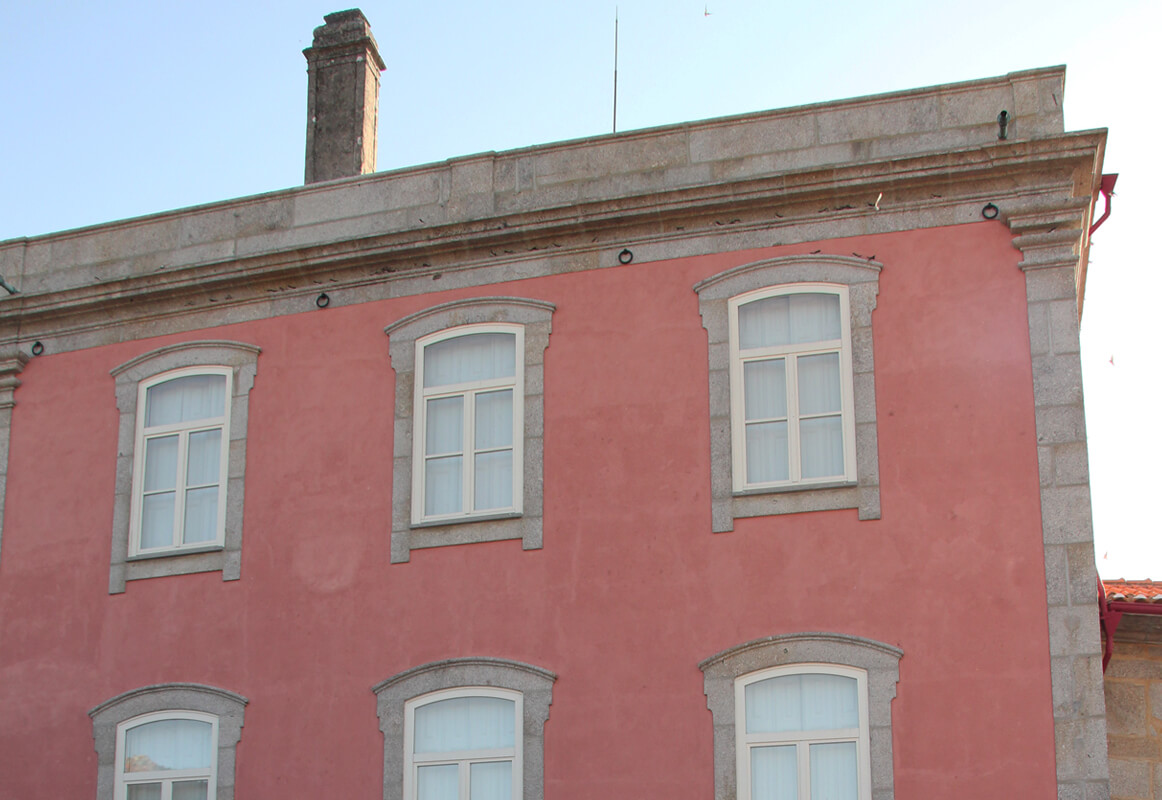
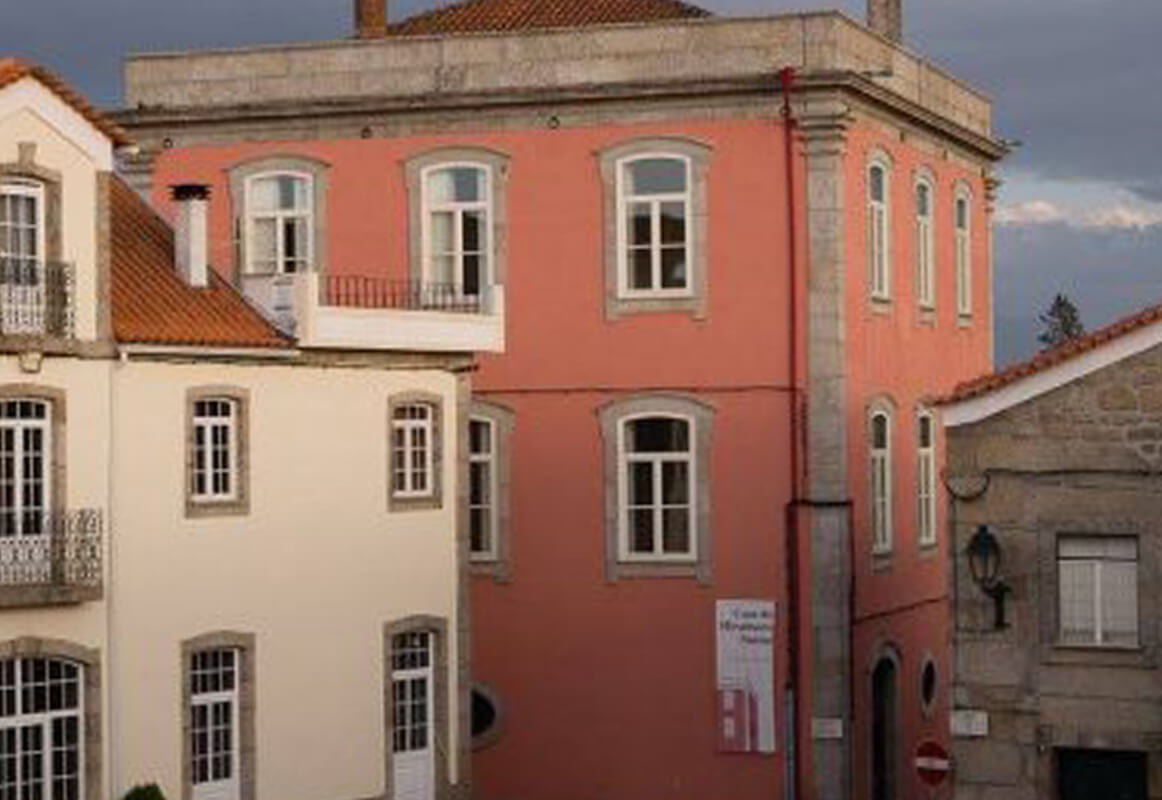
Bearer of the great changes of his time, he attends a Law Degree at the University of Coimbra. Throughout his life he dedicates himself to the study of the genealogy of Portuguese noble families. A skilled and modern farmer, he manages his agricultural house closely, always very attentive to the development and new technologies. Moreover, in 1888, the wines of his agricultural house receive, in Berlin, by the hand of the Central Association of Commercial Geography, the second prize in the Portuguese wine exhibition.
Loving father of two women, D. Dulce Eduarda de Mello and D. Alda Branca de Mello, he raises them alone and shares his life with then in the Casa do Miradouro, until 1921, the year of his death. D. Dulce Eduarda de Mello and D. Alda Branca de Mello continued the work of their father until 1937, when D. Alda married Mário Augusto de Matos.
Mário Augusto de Matos (originally from the district of Guarda), findshim self in Santar and left his law degree behind, dedicating himself to the agricultural development of Casa do Miradouro. He replants the approximately 30 hectares of vineyards belonging to the house, he builds wells, walls, and mines, completely reformulating its agricultural production. In the middle of World War II, he manages to guarantee a salary to 40 daily workers, helping him alleviate the difficult and distressing moment that Portugal and Europe were going through.
The marriage of Mário Augusto de Matos and D. Alda ends in 1968 after her death, there were no children born from this relationship.
In 1970, Mário Augusto de Matos married D. Rosa Branca Simões Pereira. From this marriage two daughters were born, Alexandrina and Alda Dulce de Matos, present owners of the Casa do Miradouro in Santar.
Chafariz da Carranca
Carranca's fountain is a revivalist example, inspired by contemporaneous copies of the eighteenth century, ordered to build by the Viscount of Taveiro, by the legacy of his uncle Pedro Paulo José de Melo, Count of Santar in 1942. Half-orange-shaped, it appears tripartite in the traditional aesthetic conception according to the taste of the elites of Beira: coat of arms of the House of Santar, cartouche with inscription and water source with gutter in bronze, from where the water flows into an uneven basin. The aesthetic principles follow the same as the Fountain of Horses, dating from 1790 and located in the gardens of Casa de Santar
Initially, the granite wall was covered with a white-washed apparatus, but later on the granite was nude, and the grayish furnishings of the pyramids with cushions and fire-fountains were emphasized more vigorously.
The fountain, placed strategically in front of the noble door of the House of Santar, makes the road interconnect with the calmness of the land above, as if they were one, merging the public and private spaces to delight the passers-by and simultaneously enriching the façade of the noble House of Santar.
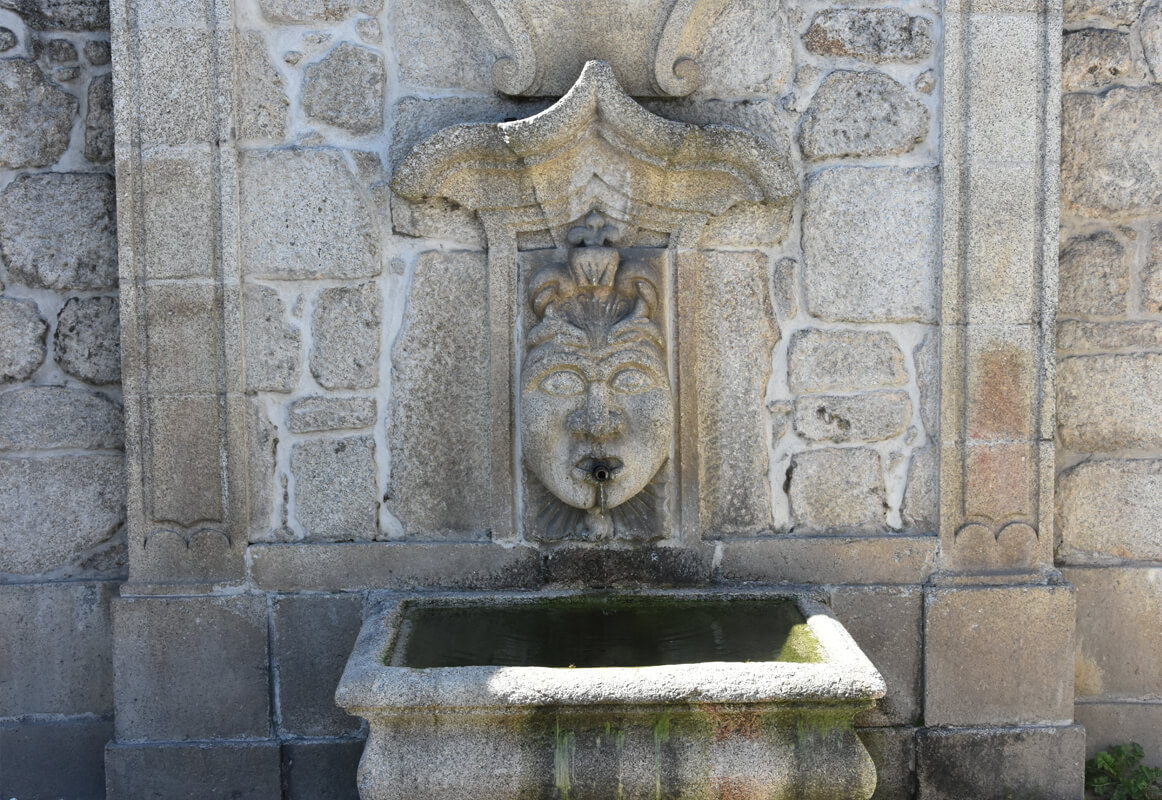
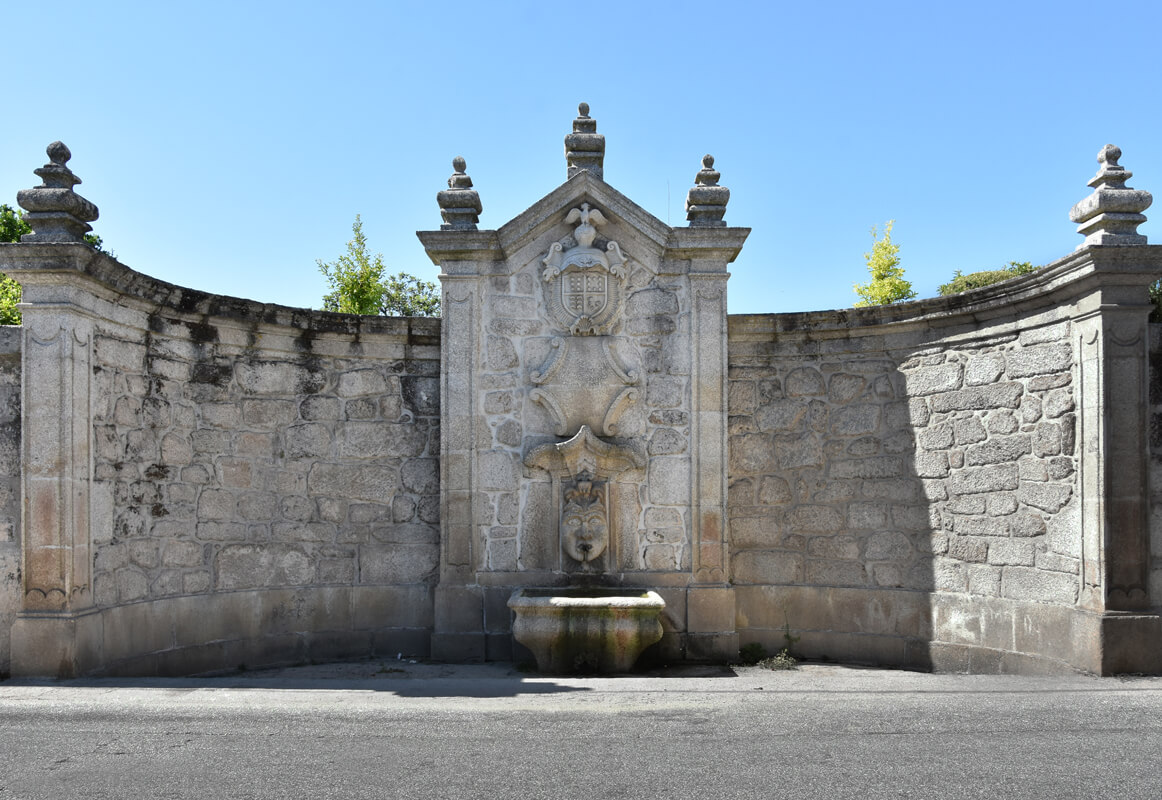
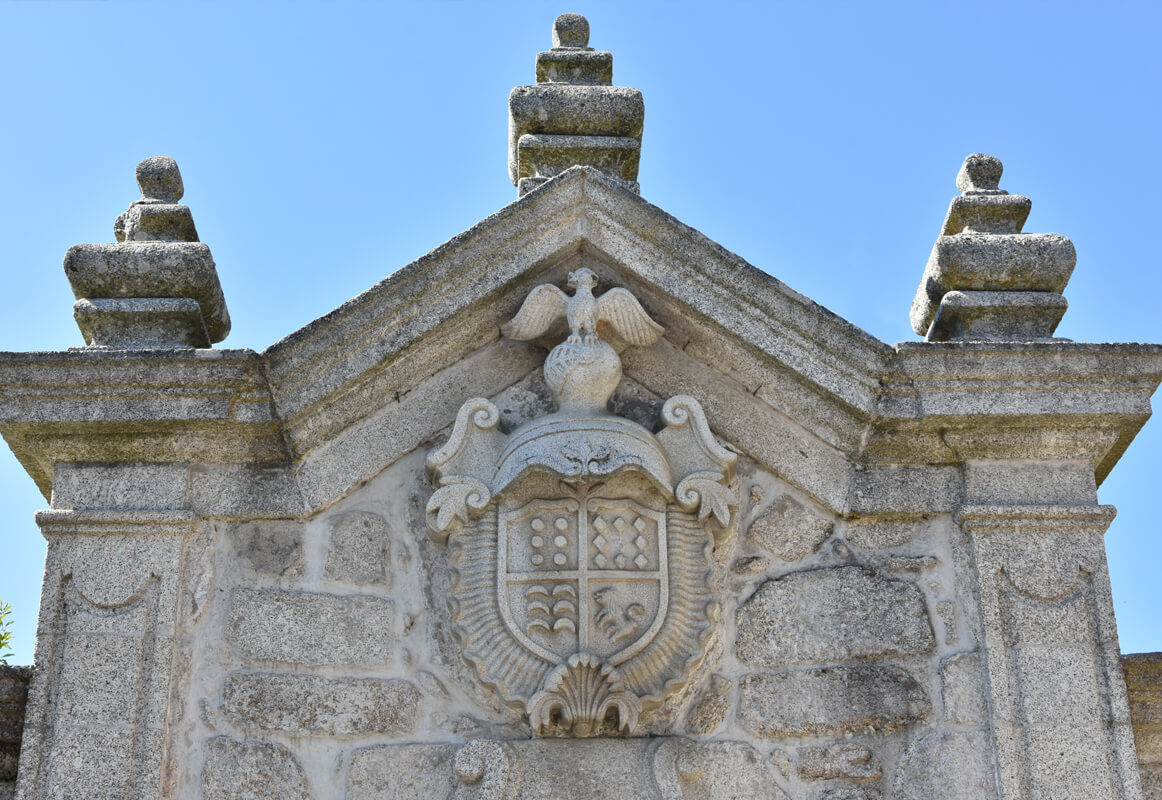
Fonte da Torre
The fountain of Casa das Fidalgas integrates the historical set of the village of Santar, located in the yard of the referred house, today called Largo da Torre.
Its construction serves as a model for the other two existing specimens in Santar, both built by the Lords of the Casa de Santar e Magalhães.
Its conservation status is quite good, allowing the population to continuously stock up on its fresh water, which runs throughout the year.
